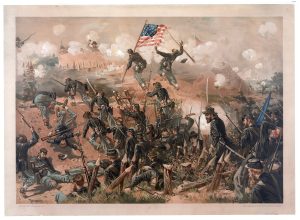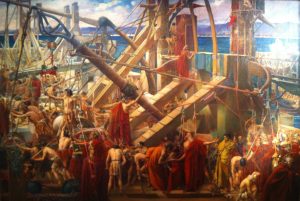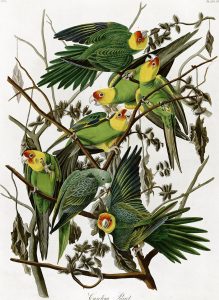Jules Verne, H. G. Wells, and Arthur C. Clarke
Jules Verne, H. G. Wells, and Arthur C. Clarke are often called the “Big Three” of science fiction, having laid the foundation for the genre and inspired countless authors and scientists. Each brought a unique perspective and style to their writing, but they shared a common interest in exploring the possibilities of science and technology.
Jules Verne (1828-1905): The Father of Science Fiction
- Focus: Verne’s stories often revolved around adventure and exploration, emphasizing technological innovation and scientific plausibility. He meticulously researched the science behind his inventions and gadgets, making his stories believable and grounded in reality.
- Famous Works: “Twenty Thousand Leagues Under the Sea,” “Journey to the Center of the Earth,” “Around the World in Eighty Days”
- Legacy: Verne is celebrated for his visionary ideas, such as submarines, space travel, and video communication, which foreshadowed technological advancements. His stories continue to inspire a sense of wonder and excitement about the possibilities of science.
H.G. Wells (1866-1946): The Social Critic
- Focus: Wells used science fiction as a vehicle for social commentary, exploring themes of social injustice, class struggle, and the potential dangers of unchecked technological progress. His stories often had a darker tone and explored the potential consequences of human actions.
- Famous Works: “The Time Machine,” “The War of the Worlds,” “The Invisible Man”
- Legacy: Wells is recognized for his thought-provoking ideas about social change, evolution, and the impact of technology on society. His works continue to spark debate and discussion about humanity’s future.
Arthur C. Clarke (1917-2008): The Visionary Futurist
- Focus: Clarke’s stories often delved into the philosophical and spiritual implications of space exploration and technological advancement. He was interested in the potential for humanity to evolve and transcend its limitations through science and technology.
- Famous Works: “2001: A Space Odyssey,” “Rendezvous with Rama,” “Childhood’s End”
- Legacy: Clarke is remembered for his visionary ideas about space exploration, artificial intelligence, and humanity’s future. His works continue to inspire awe and wonder about the possibilities of the universe.
In Summary:
While Verne, Wells, and Clarke contributed significantly to science fiction, their works differ in focus, style, and tone. Verne focused on adventure and technological innovation, Wells on social commentary and the dangers of technology, and Clarke on scientific progress’s philosophical and spiritual implications. Together, their works form a rich tapestry of ideas that have shaped our understanding of science, technology, and the future of humanity.
Jules Verne History
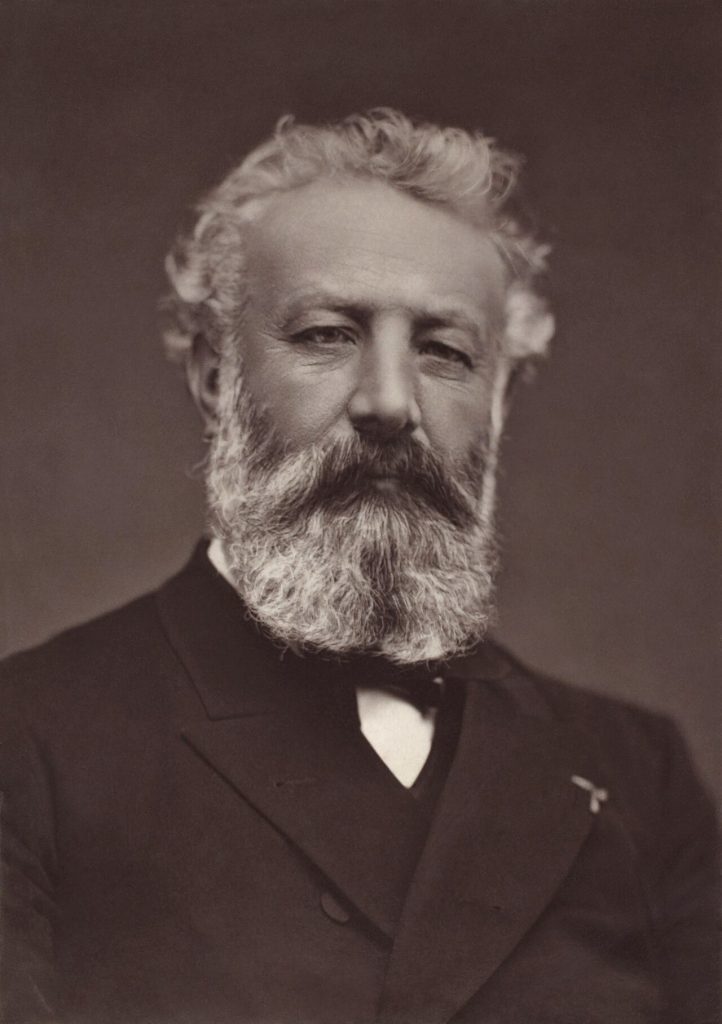
Jules Verne (Wiki Image).
“Anything one man can imagine, other men can make real.”
“The sea is everything. It covers seven-tenths of the terrestrial globe. Its breath is pure and healthy. It is an immense desert, where man is never lonely, for he feels life stirring on all sides.”
“Science, my lad, is made up of mistakes, but they are mistakes which it is useful to make, because they lead little by little to the truth.”
“We may brave human laws, but we cannot resist natural ones.”
“Solitude, isolation, are painful things and beyond human endurance.”
“Time is an illusion.”
“All that is impossible remains to be accomplished.”
“The human mind delights in grand conceptions of supernatural beings.”
“As long as the heart beats, as long as flesh quivers, I do not allow that a being gifted with thought and will allow himself to despair.”
“Ah! Young people, travel if you can, and if you cannot – travel all the same!”
“Put two ships in the open sea, without wind or tide, and, at last, they will come together. Throw two planets into space, and they will fall one on the other.”
“The Earth does not need new continents, but new men.”
“Reality provides us with facts so romantic that imagination itself could add nothing to them.”
“It is said that the night brings counsel, but it is not said that the counsel is necessarily good.”
“Liberty is worth paying for.”
| Book Title | Year Published | Plot Summary | Key Themes |
|---|---|---|---|
| Twenty Thousand Leagues Under the Sea | 1870 | Captain Nemo leads the crew of the submarine Nautilus on underwater adventures, discovering marine life and ancient ruins. | Exploration, power of nature, isolation |
| Journey to the Center of the Earth | 1864 | Professor Lidenbrock and his team descend into the Earth through volcanic tubes, encountering prehistoric life and other natural wonders. | Adventure, geology, exploration of unknown |
| Around the World in Eighty Days | 1872 | Phileas Fogg bets he can circumnavigate the globe in 80 days, leading to a thrilling adventure across continents. | Time, adventure, cultural differences |
| From the Earth to the Moon | 1865 | A post-Civil War gun club designs a cannon to send a manned projectile to the Moon. | Space exploration, human ambition |
| The Mysterious Island | 1874 | A group of castaways must survive on an island full of natural mysteries and hidden dangers. | Survival, discovery, human ingenuity |
| The Adventures of Captain Hatteras | 1866 | Captain Hatteras’s obsessive quest to reach the North Pole leads to a perilous expedition in the Arctic. | Determination, survival in extreme environments |
| The Steam House | 1880 | Travelers explore India on a steam-powered mechanical elephant, encountering various challenges. | Colonialism, technology, exploration |
| The Begum’s Fortune | 1879 | Two scientists use inherited wealth to build competing utopian cities in America—one peaceful, the other militaristic. | Idealism, conflict, unchecked ambition |
| Robur the Conqueror | 1886 | Robur, an engineer, invents a flying machine and proclaims his control over the skies. | Technology, power, conquest |
| The Master of the World | 1904 | This is a sequel to Robur the Conqueror. Robur builds a hybrid vehicle, the Terror, capable of traveling by land, sea, and air, threatening world stability. | Ambition, fear of technological dominance |
| Michael Strogoff | 1876 | Michael Strogoff, a courier for the Tsar, embarks on a perilous journey across Siberia during a Tartar rebellion to deliver an important message. | Duty, perseverance, courage |
| In Search of the Castaways | 1867 | A group is searching for Captain Grant, whose shipwreck led them across continents in search of clues. | Adventure, friendship, exploration |
Jules Verne – A Few Events In His Life
(YouTube video)
Jules Verne & Walt Disney–Explorers of the Imagination …
(YouTube video)
Jules Verne (1828-1905) was a French novelist, poet, and playwright widely considered a science fiction pioneer. His works, filled with imaginative adventures and futuristic technologies, captivated readers worldwide and inspired generations of scientists, explorers, and science fiction enthusiasts.
Early Life and Career:
- Born in Nantes, France: Jules Verne was born in the port city of Nantes, where he developed a fascination with ships and the sea. This early exposure to maritime life would later influence his writing.
- Law Studies and Literary Pursuits: Although his father wanted him to become a lawyer, Verne’s passion lay in literature and the theater. He moved to Paris to study law but spent much time writing plays and short stories.
- Collaboration with Pierre-Jules Hetzel: Verne’s career took a significant turn when he met publisher Pierre-Jules Hetzel, who recognized his talent and became his lifelong collaborator. Hetzel published Verne’s most famous novels in his “Voyages Extraordinaires” series, which brought Verne widespread recognition and success.
Literary Achievements:
- “Voyages Extraordinaires”: This series of adventure novels, which included titles like “Twenty Thousand Leagues Under the Sea,” “Journey to the Center of the Earth,” and “Around the World in Eighty Days,” cemented Verne’s reputation as a visionary writer and a pioneer of science fiction.
- Scientific Accuracy: Verne’s works were notable for their attention to scientific detail and plausibility. He often researched extensively and consulted with scientists and engineers to ensure his descriptions of futuristic technologies were as accurate as possible.
- Inspiring Future Technologies: Some of Verne’s imaginative concepts, such as submarines, space travel, and video communication, foreshadowed technological advancements in the 20th century.
Legacy:
- Father of Science Fiction: Verne is often called the “Father of Science Fiction,” although this title is sometimes shared with H.G. Wells. His works have been translated into numerous languages and continue to be read and enjoyed by people of all ages.
- Influence on Science and Exploration: Verne’s stories have inspired generations of scientists, explorers, and inventors. His visionary ideas helped to spark interest in space exploration, underwater exploration, and other scientific endeavors.
- Cultural Impact: Verne’s works have been adapted into numerous films, television shows, and other forms of media, further solidifying his place in popular culture and ensuring his legacy as one of the most influential authors of all time.
Jules Verne’s imagination and scientific curiosity led him to create stories that continue to captivate and inspire readers today. His legacy as a visionary writer and a pioneer of science fiction is secure, and his works remain a testament to the power of human imagination and the enduring appeal of adventure and exploration.
Born in Nantes, France: Jules Verne was born in the port city of Nantes, where he developed a fascination with ships and the sea. This early exposure to maritime life would later influence his writing. Law Studies and Literary Pursuits: Although his father wanted him to become a lawyer, Verne’s passion lay in literature and the theater. He moved to Paris to study law but spent much time writing plays and short stories.
Jules Verne, born in the bustling port city of Nantes, France, was captivated by the ships and the sea from a young age. This early fascination with maritime life would later become a cornerstone of his literary works, inspiring tales of underwater adventures and nautical exploration.
Despite his father’s wishes for him to pursue a legal career, Verne’s heart belonged to literature and the theater. He moved to Paris to study law, but his true passion led him to spend much of his time writing plays and short stories.
Collaboration with Pierre-Jules Hetzel: Verne’s career took a significant turn when he met publisher Pierre-Jules Hetzel, who recognized his talent and became his lifelong collaborator. Hetzel published Verne’s most famous novels in his “Voyages Extraordinaires” series, which brought Verne widespread recognition and success.
Verne’s literary journey reached a turning point when he met publisher Pierre-Jules Hetzel. Hetzel recognized Verne’s unique talent blending scientific speculation with thrilling adventure stories. The two formed a lifelong partnership, with Hetzel publishing Verne’s most famous novels in his “Voyages Extraordinaires” series. This collaboration propelled Verne to international fame and solidified his place as a science fiction pioneer.
Through Hetzel’s guidance and editorial expertise, Verne’s novels were carefully crafted and presented to the public, captivating readers with their imaginative visions of the future and thrilling journeys to uncharted territories.
Twenty Thousand Leagues Under the Sea
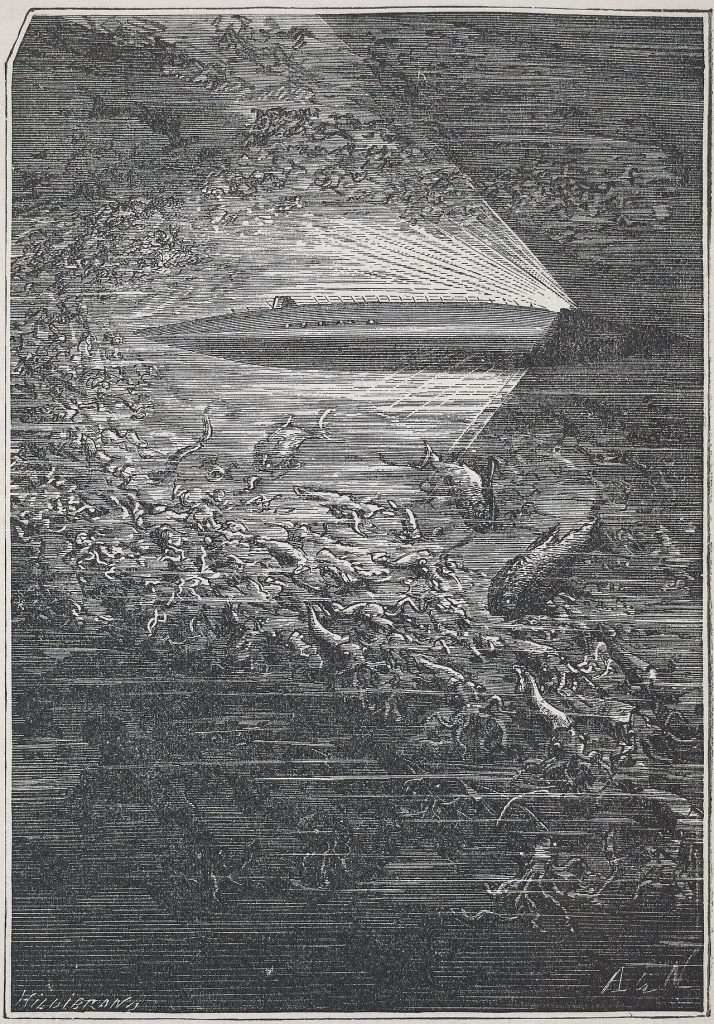
Illustration of the Nautilus by Alphonse de Neuville and Édouard Riou (Wiki Image).
Notable Quotes from Twenty Thousand Leagues Under the Sea by Jules Verne
- “The sea is everything. It covers seven-tenths of the terrestrial globe. Its breath is pure and healthy. It is an immense desert, where man is never lonely, for he feels life stirring on all sides.”
- This quote captures the vastness and vitality of the ocean, reflecting Verne’s deep appreciation for the sea.
- “We may brave human laws, but we cannot resist natural ones.”
- Here, Verne emphasizes the power and inevitability of nature’s laws, a recurring theme in his works.
- “The sea does not belong to despots. Upon its surface, men can still exercise unjust laws, fight, tear one another to pieces, and be carried away with terrestrial horrors. But at thirty feet below its level, their reign ceases, their influence is quenched, and their power disappears.”
- Verne contrasts the chaos of human society with the peaceful and impartial nature of the sea.
- “I leave you at liberty, and I expect the same of you. Your word is sufficient.”
- Captain Nemo emphasizes honor and mutual respect among those aboard the Nautilus.
- “The human mind delights in grand conceptions of supernatural beings.”
- Verne acknowledges humanity’s fascination with the unknown and the supernatural.
- “There is hope for the future, and when the world is ready for a new and better life, all this will someday come to pass—in God’s good time.”
- A hopeful vision of progress and a better future.
- “The sea is only the embodiment of a supernatural and wonderful existence. It is nothing but love and emotion; it is the Living Infinite.”
- Verne personifies the sea, highlighting its mystical and emotional significance.
- “I am not what you call a civilized man! I have done with society for reasons that seem good to me. Therefore, I do not obey its laws.”
- Captain Nemo’s declaration of independence from societal norms and laws.
- “If there were no thunder, men would have little fear of lightning.”
- This quote metaphorically explores the relationship between cause and effect, fear and danger.
- “On the surface of the ocean, men wage war and destroy each other, but down here, just a few feet beneath the waves, there is perfect peace.”
- A reflection on the contrast between the strife of human conflict and the serenity found in the ocean’s depths.
20,000 Leagues Under The Sea Theatrical Trailer
(YouTube video)
Twenty Thousand Leagues Under the Sea is a classic science fiction novel by Jules Verne, published in 1870. The story follows the adventures of Professor Aronnax, his loyal servant Conseil, and the harpooner Ned Land, who are taken aboard the mysterious submarine Nautilus after their ship is sunk.
The Nautilus is commanded by the enigmatic Captain Nemo, a brilliant but tortured soul who has renounced society and roams the ocean’s depths in his technological marvel. The novel takes readers on a thrilling journey through underwater landscapes, encountering exotic creatures and experiencing breathtaking adventures.
The story explores themes of exploration, scientific discovery, and the clash between nature and technology. It also delves into the complexities of Captain Nemo’s character, his motivations for isolation, and his conflicted relationship with the world above the waves.
Twenty Thousand Leagues Under the Sea is a captivating adventure story that reflects the possibilities and dangers of technological advancement. It remains a beloved classic, enchanting readers with its vivid descriptions, thrilling plot, and thought-provoking themes.
Mysterious Island
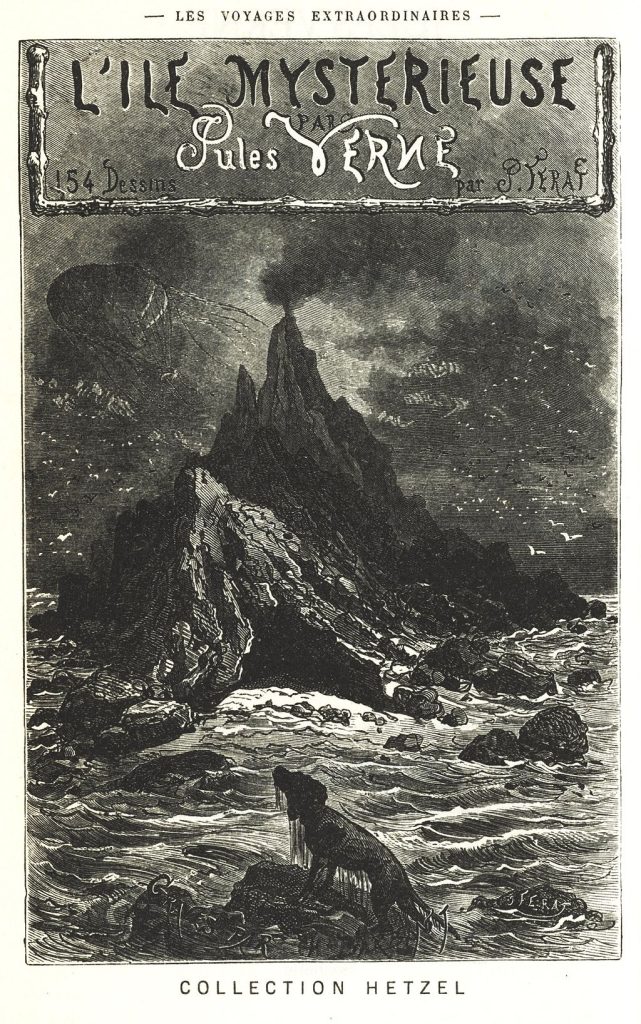
(Wiki Image).
“It is a great misfortune to be alone, my friends; and it must be believed that solitude can quickly destroy reason.” – Cyrus Harding
“Use has made me supple, concentration has hardened my nerves, and practice has made me patient.” – Pencroft
“We are here, by the will of God, and here we will stay!” – Cyrus Harding
“What could not a man do with such an instrument? He could command all nature! He could say to the elements, ‘Be still!’ He could say to the wild beasts, ‘Be tame!’ He could say to the sick, ‘Be well!’ He could even say to the dead, ‘Live!'” – Gideon Spilett (referring to a Bible)
“I believe that man was not born to be a brute, but to understand and to love. And I believe that man can only find true happiness in serving others.” – Cyrus Harding
“Why, Captain, what has become of your old comrades?” – Pencroft (to Captain Nemo)
“I believe that the future of humanity lies not in the conquest of nature, but in working with it.” – Cyrus Harding
“All great deeds and all great thoughts have a ridiculous beginning.” – Gideon Spilett
“If I have done anything wrong, I am sorry. But I cannot help it. I was born to be a sailor.” – Pencroft
“The sea is only the embodiment of a supernatural and wonderful existence. It is nothing but love and emotion; it is the ‘Living Infinite’.” – Captain Nemo
Mysterious Island (1961) ORIGINAL TRAILER [HD 1080p]
(YouTube video)
The Mysterious Island, published in 1874, is another captivating novel by Jules Verne that takes readers on an unforgettable adventure. Set during the American Civil War, the story follows a group of Union prisoners who escape in a hot air balloon and crash land on a remote, uncharted island in the Pacific Ocean.
Stranded with limited resources, the castaways must rely on their ingenuity, resourcefulness, and scientific knowledge to survive and build a new life on the island. They encounter various challenges, including hostile weather, dangerous creatures, and the mystery surrounding the island’s peculiar occurrences.
As they explore the island, they discover evidence of a mysterious benefactor who seems to be aiding them in their survival efforts. This enigmatic figure, which remains hidden for much of the novel, adds an element of intrigue and suspense to the story.
The Mysterious Island is a tale of survival, resilience, and the power of human ingenuity. It celebrates the triumph of the human spirit in the face of adversity and explores themes of friendship, loyalty, and the importance of community. The novel also incorporates science fiction elements, showcasing Verne’s fascination with technological advancements and their potential impact on society.
Journey to the Center of the Earth
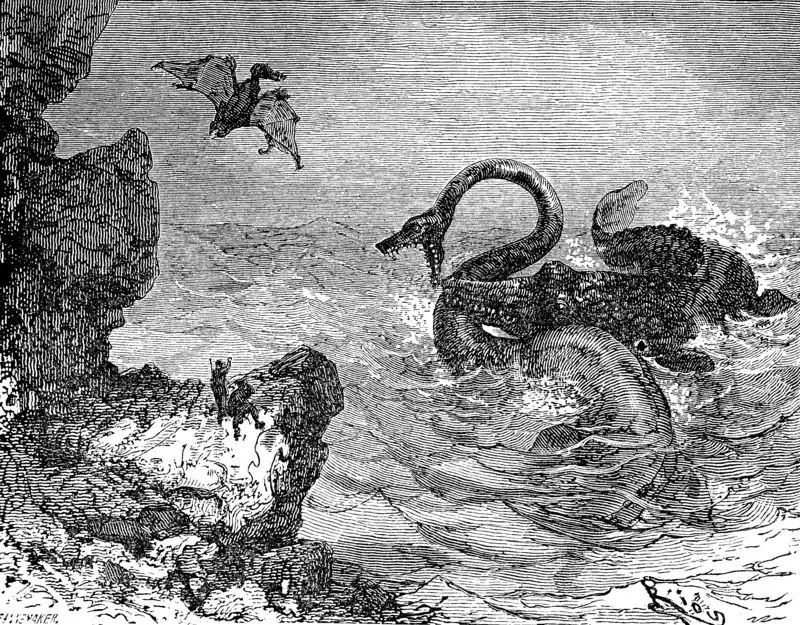
Édouard Riou illustrates an ichthyosaurus (more like a mosasaurus) battling a plesiosaurus (Wiki Image).
Notable Quotes from Journey to the Center of the Earth by Jules Verne
- “We may brave human laws, but we cannot resist natural ones.”
- This highlights the power and inevitability of nature’s laws.
- “I am perfectly aware that I have neither a scientific nor an adventurous mind.”
- This reflects the narrator’s initial hesitation and self-awareness about the journey ahead.
- “Science, my lad, is made up of mistakes, but they are mistakes that are useful to make because they lead little by little to the truth.”
- Professor Lidenbrock’s philosophy on the importance of errors in pursuing scientific knowledge.
- “There is nothing more powerful than the explorer’s instinct in man.”
- Emphasizes the innate human desire to explore and discover the unknown.
- “I dream with open eyes; I cannot let my imagination wander without running the risk of falling into a slough of despond.”
- Reflects the narrator’s struggle between imagination and reality.
- “A man of imagination in the presence of nature will sometimes go mad; he will want to invent things which do not exist.”
- Highlights the fine line between creativity and madness.
- “As long as the heart beats, as long as body and soul keep together, I cannot admit that any creature endowed with a will has need to despair of life.”
- This quote emphasizes resilience and the will to survive against all odds.
- “We are surrounded by the ocean of the great subterranean world.”
- Describes the awe-inspiring and mysterious underground environment the explorers encounter.
- “Is this the law of the Earth, to hold its secrets from mankind forever?”
- Reflects the frustration and wonder of the explorers as they delve deeper into the unknown.
- “Descend, bold traveler, into the crater of the mysterious volcano which devours men.”
- A call to adventure, urging the explorers to brave the dangerous journey ahead.
Journey To The Center Of The Earth – Original Movie Trailer …
(YouTube video)
Journey to the Center of the Earth, published in 1864, is one of Jules Verne’s most iconic science fiction novels. The story follows Professor Lidenbrock, a German geologist, and his nephew Axel as they embark on a daring expedition to the Earth’s core.
Their journey begins with discovering an ancient manuscript containing a coded message that reveals a secret passage leading to the Earth’s center. Accompanied by their Icelandic guide, Hans, they descend into the depths of an extinct volcano, encountering strange and wondrous sights along the way.
The trio faces numerous challenges and dangers as they traverse subterranean caverns and vast underground oceans and encounter prehistoric creatures thought to be extinct. They witness breathtaking landscapes and geological formations, marveling at the Earth’s hidden wonders.
Journey to the Center of the Earth is a thrilling adventure story combining scientific speculation and imaginative storytelling. It explores themes of exploration, discovery, and the mysteries that lie beneath the Earth’s surface. The novel’s vivid descriptions and imaginative scenarios continue to captivate readers of all ages.
Around the World in Eighty Days
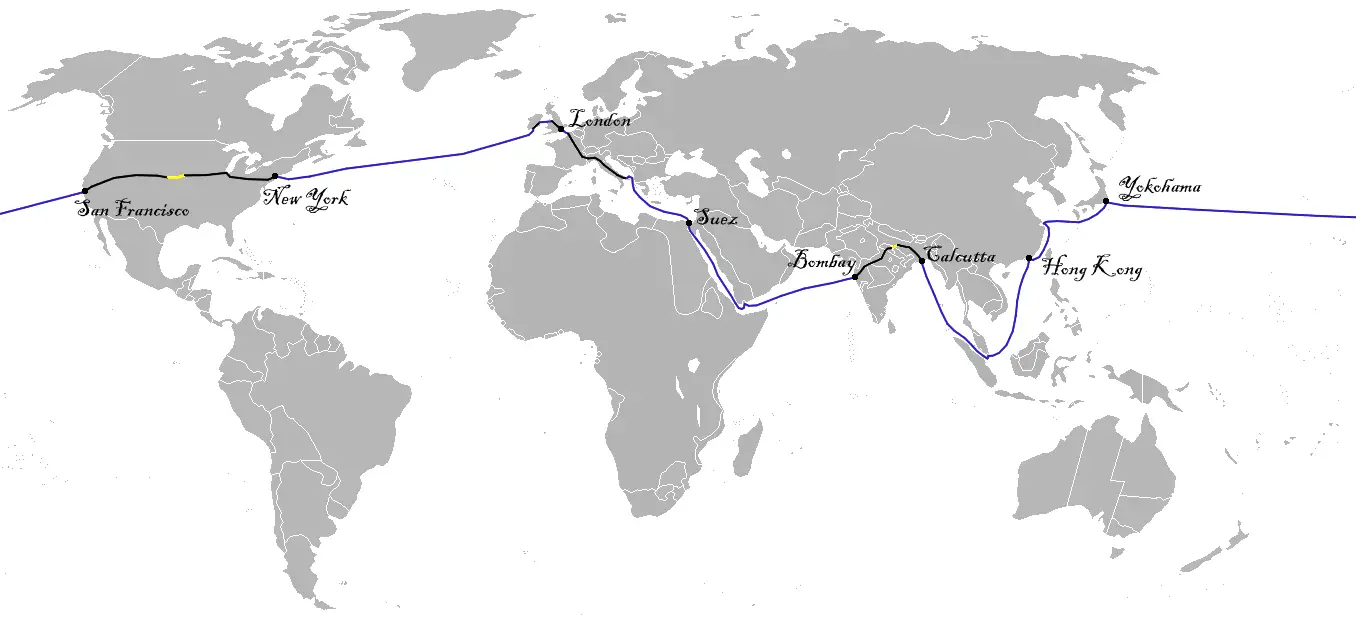
Notable Quotes from Around the World in Eighty Days by Jules Verne
- “The unforeseen does not exist.”
- Phileas Fogg’s confidence in his meticulous planning and belief in predictability.
- “A true Englishman doesn’t joke when he is talking about so serious a thing as a wager.”
- This reflects the seriousness with which Fogg takes his bet and his English demeanor.
- “The world has grown smaller since a man can now go around it ten times more quickly than a hundred years ago.”
- Commentary on the advancements in travel and communication in the 19th century.
- “I see that it is by no means useless to travel if a man wants to see something new.”
- Acknowledges the value of travel in expanding one’s horizons and experiences.
- “It is not my habit to converse with my servants.”
- Phileas Fogg’s formal and reserved nature, particularly in his interactions with his valet, Passepartout.
- “I am a citizen of the world, and I have made a vow never to stay anywhere more than a week.”
- Fogg’s dedication to his journey and his cosmopolitan outlook.
- “We shall have made the tour of the world in eighty days.”
- Fogg’s bold statement reflects his confidence in achieving the seemingly impossible task.
- “The chance which now seems lost may present itself at the last moment.”
- A hopeful perspective on the unpredictability of life and opportunities.
- “There are no longer any mountains. There are no more obstacles. There are only plains left.”
- Symbolizes the overcoming of obstacles and the boundless possibilities of human achievement.
- “This man, by his intractable obstinacy, has often made me think that his mission in life was to make my fortune.”
- Passepartout reflects on Fogg’s determination and its impact on his life.
Around the World In 80 Days (1956) Official Trailer – Cantinflas …
(YouTube video)
Around the World in Eighty Days, published in 1873, is one of Jules Verne’s most celebrated adventure novels. The story follows the wealthy and eccentric Phileas Fogg, a man of habit and precision, who embarks on a wager to circumnavigate the globe in eighty days.
Accompanied by his newly hired French valet, Passepartout, Fogg sets off from London on an ambitious journey that takes them across continents and oceans. They face numerous obstacles, including transportation delays, cultural misunderstandings, and accusations of a crime Fogg didn’t commit.
Their journey is a race against time, as they utilize various modes of transportation, from trains and steamships to elephants and even a sled powered by a sail. Along the way, they encounter diverse cultures, breathtaking landscapes, and unexpected challenges that test their resilience and determination.
Around the World in Eighty Days is a thrilling adventure story that celebrates human ingenuity, perseverance, and the power of friendship. It captures the spirit of exploration and the excitement of discovering new cultures and places. The novel’s fast-paced plot, colorful characters, and vivid descriptions of exotic locales have made it a beloved classic that inspires wanderlust and a sense of adventure in readers of all ages.
From the Earth to the Moon: A Direct Route in 97 Hours, 20 Minutes
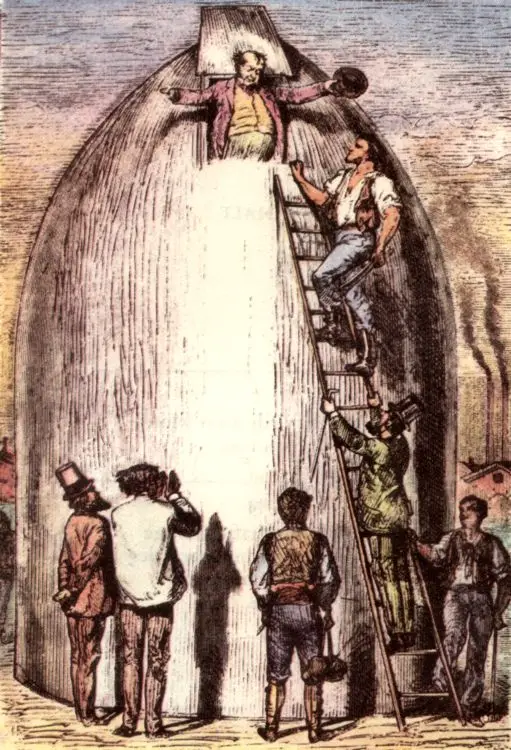 The projectile is pictured in an engraving from the 1872 Illustrated Edition (Wiki Image).
The projectile is pictured in an engraving from the 1872 Illustrated Edition (Wiki Image).
“From the Earth to the Moon: A Direct Route in 97 Hours, 20 Minutes” by Jules Verne is a pioneering science fiction novel that envisions human space travel. Here are ten notable quotes from the book:
- “Science, my lad, is made up of mistakes, but they are mistakes which it is useful to make, because they lead little by little to the truth.”
- “We may brave human laws, but we cannot resist natural ones.”
- “Man is never perfect, nor contented.”
- “Impey Barbicane, President of the Gun Club, one of the most remarkable men of the Union.”
- “To be sure, it is not a small matter to fire a projectile at the moon!”
- “The moon, gentlemen, has at least the advantage of removing us from this earth and transporting us into a new world.”
- “A cannon-shot, launched with sufficient initial velocity, would be able to make the tour of the earth without difficulty.”
- “Gentlemen, the most simple way to go to the moon would be to start from the summit of a high mountain.”
- “The moon, which the earth incessantly follows, would, at the same time, be advancing toward the same goal.”
- “Thus it is that we shall pay our debts to the moon.”
1958 From The Earth To The Moon Trailer
(YouTube video)
From the Earth to the Moon: A Direct Route in 97 Hours, 20 Minutes (French: De la Terre à la Lune, trajet direct en 97 heures 20 minutes) is an 1865 science fiction novel by Jules Verne.
The story centers on the Baltimore Gun Club, a post-American Civil War society of weapons enthusiasts, and their ambitious project to build an enormous Columbiad space gun and launch a projectile carrying three men to the Moon.
The novel follows the Gun Club’s president, Impey Barbicane, his rival, Captain Nicholl, and a French adventurer, Michel Ardan, as they prepare for their daring journey. It details their technical challenges, the public excitement surrounding the project, and the projectile’s ultimate launch.
While the story ends with the projectile successfully launched, the fate of the astronauts is left uncertain, setting the stage for Verne’s sequel, Around the Moon (1870), which details their journey and return to Earth.
From the Earth to the Moon is notable for its detailed descriptions of the scientific and engineering principles involved in space travel, as well as its imaginative portrayal of a lunar expedition. Although written over a century before the first Moon landing, the novel demonstrates Verne’s remarkable foresight and ability to blend scientific speculation with thrilling adventure.
Scientific Accuracy: Verne’s works were notable for their attention to scientific detail and plausibility. He often researched extensively and consulted with scientists and engineers to ensure his descriptions of futuristic technologies were as accurate as possible.
Jules Verne’s commitment to scientific accuracy was a defining characteristic of his writing. He meticulously researched his time’s latest scientific discoveries and technological advancements, consulting with experts to ensure the plausibility of his futuristic visions. This dedication to realism helped to distinguish his works and make them more engaging for readers.
Some notable examples of Verne’s accurate predictions include:
- Submarines: In “Twenty Thousand Leagues Under the Sea,” Verne described the Nautilus, a submarine with remarkable capabilities that foreshadowed the development of modern submarines.
- Electrically Powered Vehicles: Verne envisioned electric cars and other electrically powered vehicles in several of his novels, anticipating the rise of electric transportation in the 21st century.
- News Broadcasting: In “In the Year 2889,” Verne describes a system of news broadcasting that resembles modern television news.
While not all of Verne’s predictions came to pass, his commitment to scientific accuracy helped to establish science fiction as a genre that could both entertain and educate readers. His works continue to inspire scientists, inventors, and explorers, demonstrating the power of imagination grounded in scientific understanding.
Inspiring Future Technologies: Some of Verne’s imaginative concepts, such as submarines, space travel, and video communication, foreshadowed technological advancements in the 20th century.
Jules Verne’s visionary ideas entertained readers and inspired inventors and scientists to bring his imaginative concepts to life. Some of his most notable predictions that foreshadowed technological advancements in the 20th century include:
Submarines: Verne’s depiction of the Nautilus in “Twenty Thousand Leagues Under the Sea” was remarkably prescient, envisioning a self-sufficient underwater vessel capable of long-range travel and exploration. This inspired the development of modern submarines, which play a crucial role in naval operations and scientific research.
Space Travel: In “From the Earth to the Moon” and “Around the Moon,” Verne described the concept of space travel using projectile-like capsules launched from giant cannons. While this method differed from actual spaceflight, his vision of humans venturing beyond Earth and exploring the moon was remarkably prophetic.
Video Communication: In “In the Year 2889,” Verne describes a device called the “phonotelephote,” which allows people to see and hear each other from a distance. This concept anticipates the development of video communication technologies like video conferencing and live streaming.
Verne’s ability to envision and describe these technologies with such accuracy is a testament to his creative genius and keen understanding of scientific principles. His works inspire and challenge us to push the boundaries of what is possible, reminding us that even the most fantastical ideas can become reality through human ingenuity and perseverance.
Father of Science Fiction: Verne is often called the “Father of Science Fiction,” although this title is sometimes shared with H.G. Wells. His works have been translated into numerous languages and continue to be read and enjoyed by people of all ages.
Jules Verne is often called the “Father of Science Fiction,” a title that recognizes his pioneering role in shaping the genre. While this title is sometimes shared with H.G. Wells, Verne’s imaginative and scientifically grounded stories laid the groundwork for modern science fiction.
Verne’s works have transcended time and language barriers, with translations available in countless languages worldwide. His stories continue to captivate readers of all ages, sparking their imagination and inspiring a sense of wonder about the possibilities of science and technology.
Verne’s legacy as the “Father of Science Fiction” is cemented by the enduring popularity of his works and their lasting impact on literature, film, and popular culture. His imaginative visions of the future resonate with readers today, reminding us of the power of human ingenuity and the endless possibilities of exploration and discovery.
Influence on Science and Exploration: Verne’s stories have inspired generations of scientists, explorers, and inventors. His visionary ideas helped to spark interest in space exploration, underwater exploration, and other scientific endeavors.
Jules Verne’s imaginative stories have had a profound and lasting influence on science and exploration. His visionary ideas captured the imaginations of countless scientists, explorers, and inventors, inspiring them to push the boundaries of human knowledge and achievement.
Some notable examples of Verne’s influence include:
-
- Space Exploration: Verne’s depictions of space travel in “From the Earth to the Moon” and “Around the Moon” are credited with inspiring pioneers like Konstantin Tsiolkovsky, Hermann Oberth, and Robert Goddard, who laid the groundwork for modern rocketry and spaceflight. Astronauts have even cited Verne’s works as sources of inspiration for their journeys into space.
-
- Underwater Exploration: The detailed descriptions of submarine technology in “Twenty Thousand Leagues Under the Sea” fueled the imagination of inventors and engineers, leading to advancements in submarine design and underwater exploration. Today, submarines are vital tools for scientific research and military operations.
-
- Aviation: While Verne’s novels focused more on underwater and space travel, his portrayal of flying machines in works like “Robur the Conqueror” sparked interest in aviation and may have influenced early aviation pioneers.
Verne’s legacy continues to inspire scientists, explorers, and inventors today. His visionary ideas remind us that the boundaries of human knowledge and achievement are constantly expanding and that, with imagination and perseverance, we can continue to explore and discover new frontiers.
Cultural Impact: Verne’s works have been adapted into numerous films, television shows, and other forms of media, further solidifying his place in popular culture and ensuring his legacy as one of the most influential authors of all time.
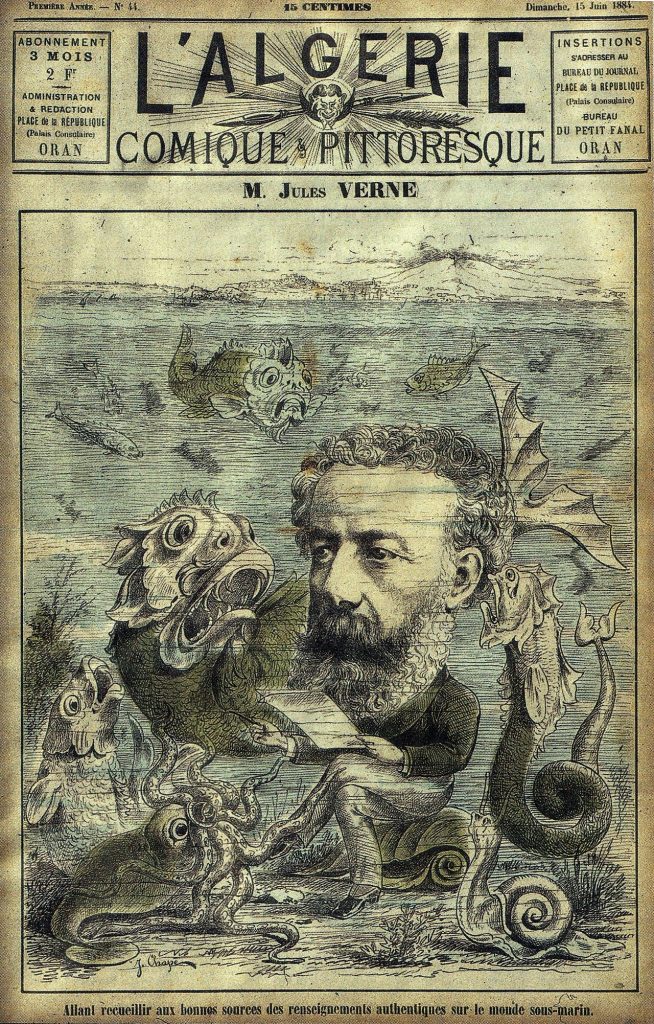
Caricature of Verne with fantastic sea life (1884) (Wiki Image).
Absolutely! Jules Verne’s impact on popular culture is immense and far-reaching. His imaginative stories have captivated readers for generations and have been adapted into numerous forms of media, cementing his place as a cultural icon and a beloved figure in literary history.
Here’s a glimpse into his cultural impact:
- Film Adaptations: Verne’s novels have been adapted into numerous films, ranging from early silent films to modern blockbusters. Some notable examples include Disney’s “20,000 Leagues Under the Sea” (1954), “Journey to the Center of the Earth” (1959 and 2008), and “Around the World in 80 Days” (1956 and 2004). These films have introduced Verne’s stories to new audiences and helped to popularize his imaginative concepts.
- Television Adaptations: Verne’s works have also been adapted for television, with series like “The Mysterious Island” and “Journey to the Center of the Earth” bringing his adventures to the small screen.
- Animation and Comics: Verne’s stories have inspired animated films and television series, such as “Nadia: The Secret of Blue Water,” which draws heavily on the themes and imagery of “20,000 Leagues Under the Sea.” His works have also been adapted into comic books and graphic novels, reaching new readers through different mediums.
- Theme Parks and Attractions: Verne’s imaginative worlds have been brought to life in theme parks and attractions worldwide. Disneyland Paris features a “20,000 Leagues Under the Sea” attraction, while Vulcania, a theme park in France dedicated to volcanoes, includes exhibits inspired by “Journey to the Center of the Earth.”
- Music and Art: Verne’s stories have inspired musical compositions, paintings, and other forms of artistic expression. His imaginative visions of the future have resonated with artists across various disciplines. Countless authors have been inspired by Verne’s work, creating new science fiction stories and subgenres.
The continued popularity of Jules Verne’s works across different media platforms is a testament to his enduring legacy and the timeless appeal of his stories. His imaginative ideas, scientific curiosity, and adventurous spirit continue to capture the imagination of people worldwide, making him one of the most influential authors of all time.
H. G. Wells History
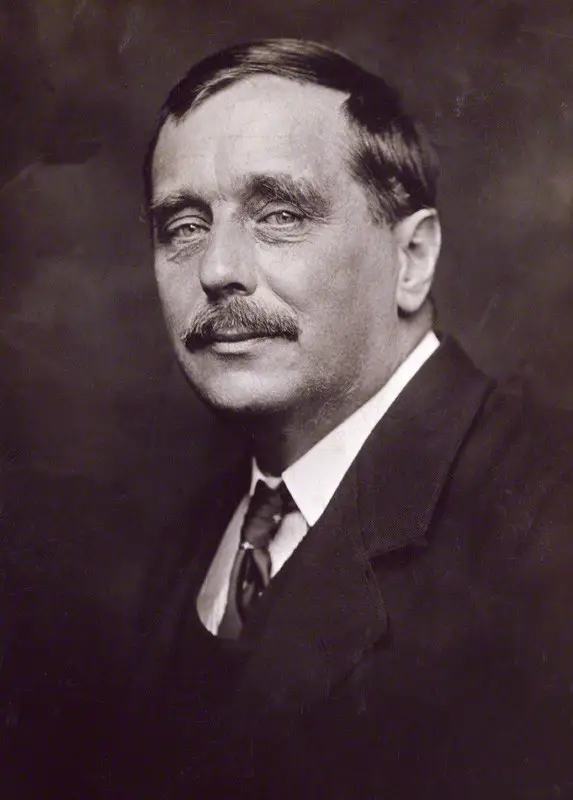
H. G. Wells (Wiki Image).
“If we don’t end the war, war will end us.”
“Adapt or perish, now as ever, is nature’s inexorable imperative.”
“Human history becomes more and more a race between education and catastrophe.”
“The crisis of today is the joke of tomorrow.”
“We all have our time machines, don’t we? Those that take us back are memories… And those that carry us forward are dreams.”
“The past is but the beginning of a beginning, and all that is and has been is but the twilight of the dawn.”
“Moral indignation is jealousy with a halo.”
“If you fell down yesterday, stand up today.”
“Our true nationality is mankind.”
“The forceps of our minds are clumsy forceps and crush the truth a little in taking hold of it.”
“Advertising is legalized lying.”
“Every time I see an adult on a bicycle, I no longer despair for the future of the human race.”
“Statistical thinking will one day be as necessary for efficient citizenship as the ability to read and write!”
“Civilization is in a race between education and catastrophe. Let us learn the truth and spread it as far and wide as our circumstances allow. For the truth is the greatest weapon we have.”
“The man who makes everything that leads to happiness depends upon himself, and not upon other men, has adopted the very best plan for living happily.”
| Book Title | Year Published | Plot Summary | Key Themes |
|---|---|---|---|
| The Time Machine | 1895 | A scientist invents a machine that allows him to travel through time, exploring the distant future and witnessing the decay of human civilization. | Time travel, social evolution, dystopia |
| The War of the Worlds | 1898 | Martians invade Earth, leading to a catastrophic war between the technologically advanced invaders and humanity. | Alien invasion, survival, imperialism |
| The Invisible Man | 1897 | A scientist named Griffin discovers how to make himself invisible, but the power leads him down a path of madness and violence. | Isolation, power, the dangers of science |
| The Island of Doctor Moreau | 1896 | Edward Prendick is stranded on an island where Dr. Moreau conducts cruel experiments, transforming animals into human-like creatures. | Ethics of science, cruelty, nature of humanity |
| The First Men in the Moon | 1901 | A scientist and a businessman travel to the Moon, discovering a subterranean alien race and facing the challenges of survival and escape. | Space exploration, colonialism, utopian ideals |
| The Sleeper Awakes | 1910 | A man falls asleep for 200 years and wakes up to a future where he controls a vast fortune, only to find himself in turmoil at the center of a dystopian society. | Dystopia, capitalism, revolution |
| The Shape of Things to Come | 1933 | A futuristic account of world events from the 20th century through a destructive world war, leading to a technocratic utopia. | War, societal transformation, utopia |
| The Food of the Gods | 1904 | A substance that accelerates growth is created, leading to giant animals and humans and resulting in social and ecological upheaval. | Unintended consequences of science, power |
| When the Sleeper Wakes | 1899 | Graham falls into a deep sleep and wakes in the future, where he is the wealthiest man alive in a world controlled by corporations. | Capitalism, exploitation, dystopia |
| The War in the Air | 1908 | The invention of flight leads to a devastating global war with catastrophic consequences for civilization. | War, technology, the decline of civilization |
| Tono-Bungay | 1909 | A man reflects on his involvement with a quack patent medicine company that rises to success and then collapses, reflecting on British society at the turn of the century. | Greed, morality, decline of empires |
| Kipps | 1905 | A young man of humble origins unexpectedly inherits a fortune and struggles to navigate his new position in society. | Class, wealth, identity |
H.G. Wells: Time Traveler | Full Documentary | Biography
(YouTube video)
H.G. Wells (1866-1946) was a prolific English writer considered one of the fathers of science fiction. He was also a social commentator, historian, and visionary who explored themes of social progress, evolution, and the impact of technology on society.
Early Life and Education:
- Born into a lower-middle-class family in Bromley, Kent, England.
- Faced financial struggles and worked as a draper’s apprentice and a teacher before earning a scholarship to the Normal School of Science (now Imperial College London).
- Studied biology under Thomas Henry Huxley, a prominent supporter of Darwin’s theory of evolution.
Literary Career:
- Began his writing career with science fiction novels, including “The Time Machine” (1895), “The Island of Doctor Moreau” (1896), “The Invisible Man” (1897), and “The War of the Worlds” (1898).
- These early works established him as a leading figure in science fiction, exploring themes of time travel, genetic engineering, invisibility, and alien invasion.
- Later, he expanded his writing to include social commentary, utopian and dystopian fiction, and historical and scientific works.
- Some of his notable later works include “The Outline of History” (1920), “Men Like Gods” (1923), and “The Shape of Things to Come” (1933).
Social and Political Activism:
- Was a vocal advocate for social reform and progressive causes.
- A member of the Fabian Society, a socialist organization that aimed to bring about social change through gradual reforms.
- Advocated for international cooperation, world peace, and establishing a world government.
- He believed in the power of education and science to improve society and human life.
Legacy:
- Considered one of the most influential figures in science fiction, having influenced countless authors and filmmakers.
- His works continue to be adapted and reinterpreted for modern audiences.
- His ideas about social progress, technological advancement, and the future of humanity remain relevant and thought-provoking.
- He is remembered for his intellectual curiosity, social conscience, and unwavering belief in the power of human potential.
H.G. Wells’ life and work are testaments to the power of imagination and the importance of critical thinking about the future. His writings continue to challenge and inspire readers, encouraging them to consider the possibilities and consequences of technological progress and humanity’s role in shaping their destiny.
H.G. Wells was born into a lower-middle-class family in Bromley, Kent, England. Faced financial struggles and worked as a draper’s apprentice and a teacher before earning a scholarship to the Normal School of Science (now Imperial College London). They studied biology under Thomas Henry Huxley, a prominent supporter of Darwin’s theory of evolution.
H.G. Wells was born into a lower-middle-class family in Bromley, Kent, England. Growing up, he faced financial challenges and had to work various jobs, including a draper’s apprentice and a teacher, to make ends meet. However, his intellectual curiosity and thirst for knowledge led him to pursue higher education.
Wells’ determination paid off when he earned a scholarship to the prestigious Normal School of Science (now Imperial College London). There, he studied biology under the renowned Thomas Henry Huxley, a staunch advocate of Charles Darwin’s theory of evolution. Huxley’s teachings and the scientific environment at the Normal School significantly influenced Wells’ thinking and shaped his later works.
This educational foundation in science and evolutionary theory would later become evident in Wells’ writing, particularly in his science fiction novels. He often explored themes of evolution, social progress, and the potential impact of science and technology on humanity. Wells’ early struggles and academic journey laid the groundwork for his prolific career as a writer and social commentator.
These early works established him as a leading figure in science fiction, exploring themes of time travel, genetic engineering, invisibility, and alien invasion.
“The Time Machine” (1895)
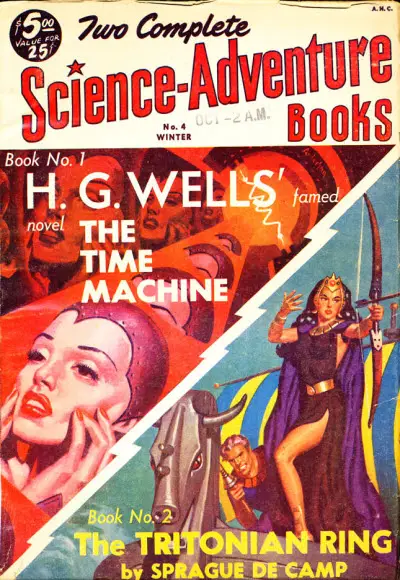
The Time Machine was reprinted in Two Complete Science-Adventure Books in 1951 (Wiki Image).
- “There is no difference between Time and any of the three dimensions of Space except that our consciousness moves along it.”
- “It is a law of nature we overlook, that intellectual versatility is the compensation for change, danger, and trouble.”
- “Nature never appeals to intelligence until habit and instinct are useless. There is no intelligence where there is no change and no need for change. Only those animals partake of intelligence that has to meet a huge variety of needs and dangers.”
- “Strength is the outcome of need; security sets a premium on feebleness.”
- “Life is not meant to be easy, my friend, but take courage: it can be delightful.”
- “It seemed to me that I had happened upon humanity upon the wane. The ruddy sunset of mankind.”
- “I saw the moon spinning swiftly through her quarters from new to full and had a faint glimpse of the circling stars. Presently, as I went on, still gaining velocity, the palpitation of night and day merged into one continuous greyness.”
- “The Time Traveller paused, put his hand into his pocket, and silently placed two withered flowers, not unlike very large white mallows, upon the little table. Then he resumed his narrative.”
- “I have no doubt they found my second appearance strange enough, coming suddenly out of the quiet darkness with inarticulate noises and the splutter and flare of a match.”
- “So I traveled, stopping ever and again, in great strides of a thousand years or more, drawn on by the mystery of the earth’s fate, watching with a strange fascination the sun grow larger and duller in the westward sky and the life of the old earth ebb away.”
The Time Machine Official Trailer #1 – Rod Taylor Movie (1960 …
(YouTube video)
“The Time Machine” (1895) is a groundbreaking science fiction novella by H.G. Wells that introduced the concept of time travel to the world. The story follows a Victorian-era inventor known only as the Time Traveller, who builds a machine capable of transporting him through time.
The Time Traveller embarks on a journey into the distant future, 802,701 AD, where he encounters a seemingly idyllic society of childlike beings called the Eloi. However, he soon discovers a darker truth about this future world. The Eloi are preyed upon by the Morlocks, a brutish underground-dwelling species who have evolved from the working class.
The novella explores themes of evolution, social class, and the potential consequences of technological advancement. It raises questions about the nature of humanity, the dangers of complacency, and the importance of social responsibility.
“The Time Machine” has had a lasting impact on science fiction and popular culture, inspiring countless adaptations and interpretations. It remains a classic work that continues to spark discussions about humanity’s future and the potential consequences of our choices.
“The Island of Doctor Moreau” (1896)
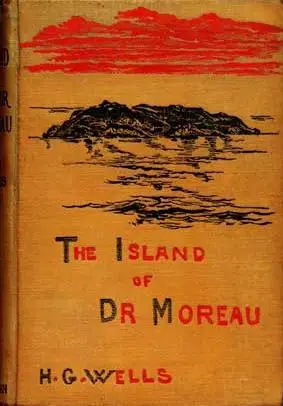
(Wiki image).
“The study of Nature makes a man at last as remorseless as Nature.” – Dr. Moreau
“It was the wantonness of it that stirred me.” – Prendick (referring to Moreau’s experiments)
“Not to go on all-fours; that is the Law. Are we not Men?” – The Sayer of the Law
“Then I saw, with a start, that a man was coming over the brow of the hill… He was a misshapen man, short, broad, and clumsy, with long arms that hung down in front of him and a face that was a caricature of humanity.” – Prendick
“The pain of dying is not nearly as bad as the pain of living.” – Montgomery
“To this day, I have never troubled about the ethics of the matter. The study of Nature makes a man at last as remorseless as Nature.” – Dr. Moreau
“The creature’s face was turned for one brief instant out of the dimness of the shadow towards the light. It was a human face or rather a human likeness, but the eyes were vacant and staring, and the features contorted into an expression of hatred and fear.” – Prendick
“The Law, the Law. We are not Men. We may not eat flesh or fish. We may not kill the things that live. The Law, the Law.” – The Beast People
“I am content to be a Beast People. I am content to escape from the pain of life. I am content to be free from the fear of death.” – The Beast People
“Then I realized I was alone. There was no one to help me. No one to understand. I was a man lost on a strange island, surrounded by monstrous creatures. I was alone.” – Prendick
The Island of Dr. Moreau Official Trailer #1 – Burt Lancaster …
(YouTube video)
“The Island of Doctor Moreau” (1896) is a science fiction novel by H.G. Wells that explores the dark side of scientific experimentation and raises ethical questions about humanity’s relationship with nature.
The story follows Edward Prendick, a shipwrecked man rescued and brought to a mysterious island ruled by the sinister Dr. Moreau.
Prendick soon discovers that Moreau is engaged in horrifying experiments, creating grotesque human-like creatures through vivisection and other cruel methods. These creatures, known as the Beast Folk, are a disturbing mix of human and animal characteristics.
As Prendick learns more about Moreau’s twisted experiments, he confronts the ethical implications of manipulating nature and the potential consequences of unchecked scientific ambition. The novel delves into themes of pain, cruelty, moral responsibility, and the boundaries of human intervention in the natural world.
“The Island of Doctor Moreau” remains a chilling and thought-provoking work that continues to challenge readers with its disturbing vision of scientific experimentation and its exploration of the dark side of human nature.
“The Invisible Man” (1897)
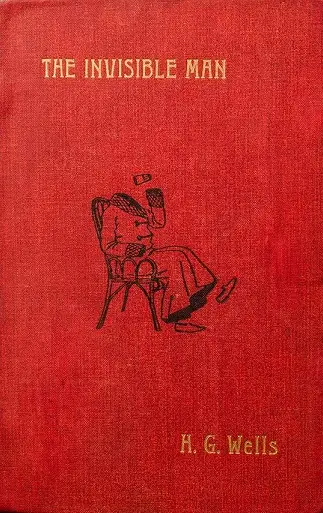
The Invisible Man (Wiki Image).
Here are ten notable quotes from H.G. Wells’ “The Invisible Man” (1897):
- “The stranger came early in February, one wintry day, through a biting wind and a driving snow, the last snowfall of the year, over the down, walking from Bramblehurst railway station, and carrying a little black portmanteau in his thickly gloved hand.”
- “I went over the heads of the things a man reckons desirable. No doubt invisibility made it possible to get them, but it made it impossible to enjoy them when they are got.”
- “I beheld, unclouded by doubt, a magnificent vision of all that invisibility might mean to a man—the mystery, the power, the freedom.”
- “An invisible man is a man of power.”
- “It’s horrible enough. But I believe there’s worse to come. I believe that man has made himself invisible. It’s the only way to account for it. And it’s the only thing that explains all the sudden appearances of my money in your place.”
- “I began to think of all the wild and wonderful things I had read in my boyhood. Of the influences of a great life. Of the love and tenderness that every human being needs.”
- “I went over the heads of the things a man reckons desirable. No doubt invisibility made it possible to get them, but it made it impossible to enjoy them when they are got.”
- “It’s not what a man would do alone, but what circumstances will bring him to do in company.”
- “There is an invisible man on the premises, and the mother—poor wretch—is just as God made her, and as for the man, he is but one of the many who have been turned out by want of bread.”
- “I made a mistake, Kemp, a huge mistake, in carrying this thing through alone. I have wasted strength, time, and opportunities. Alone— it is wonderful how little a man can do alone! To rob a little, to hurt a little, and there is the end.”
The Invisible Man – Official Trailer (Universal Pictures) HD
(YouTobe video)
H.G. WELLS’ THE INVISIBLE MAN (1958) | Official Trailer
(YouTobe video)
THE INVISIBLE MAN – 1933 Classic Horror Trailer (Claude …
(YouTobe video)
“The Invisible Man” (1897) is a science fiction novel by H.G. Wells that explores the themes of invisibility, scientific ambition, and the consequences of unchecked power.
The story revolves around Griffin, a brilliant but morally corrupt scientist who discovers a way to make himself invisible. Initially driven by curiosity and a thirst for knowledge, Griffin’s invisibility becomes a tool for personal gain and revenge.
As Griffin’s invisibility grants him anonymity and freedom from social constraints, he descends into madness and resorts to increasingly violent and antisocial behavior. He terrorizes the small village of Iping, where he seeks refuge, and eventually becomes a fugitive from the law.
The novel raises ethical questions about using scientific discoveries and the dangers of unchecked power. It explores the consequences of isolation, the erosion of empathy, and the potential for good or evil inherent in human nature.
“The Invisible Man” is a classic work of science fiction that continues to captivate readers with its suspenseful plot, complex characters, and thought-provoking themes. It has been adapted numerous times for film and television, cementing its place as a cultural icon.
“The War of the Worlds” (1898)
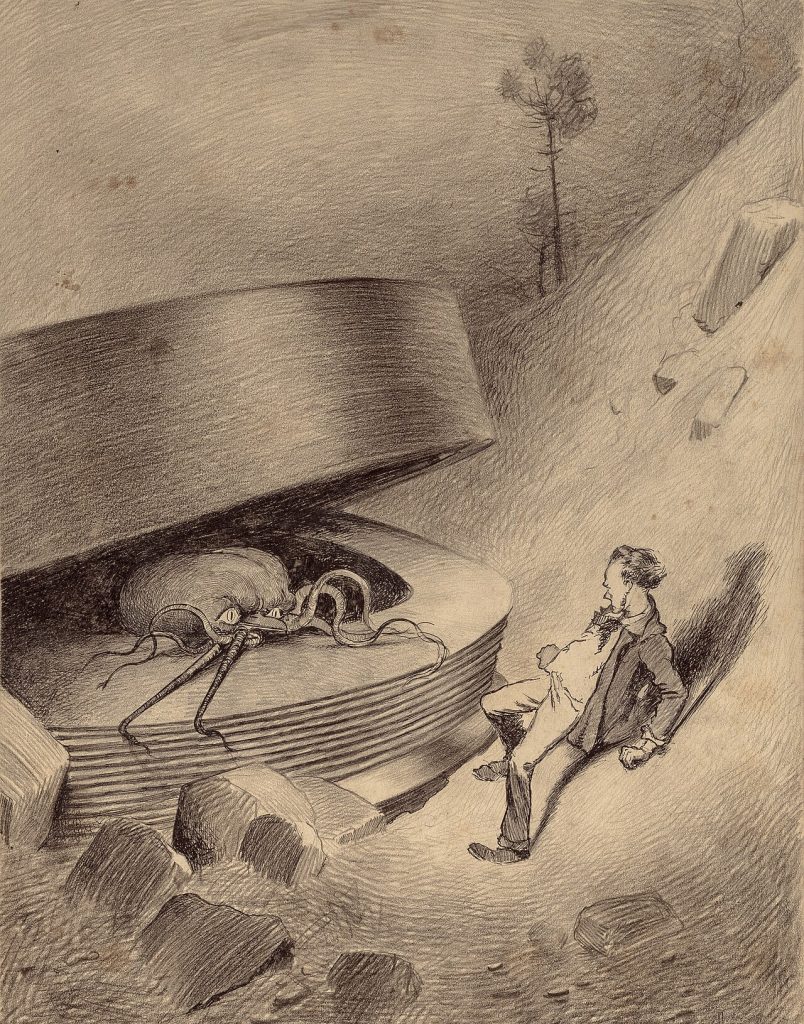
(Wiki Image).
No one would have believed in the last years of the nineteenth century that this world was being watched keenly and closely by an intelligence greater than man’s and yet as mortal as his own; that as men busied themselves about their various concerns, they were scrutinized and studied, perhaps almost as narrowly as a man with a microscope might scrutinize the transient creatures that swarm and multiply in a drop of water. With infinite complacency, men went to and fro over this globe about their little affairs, serene in their assurance of their empire over matter. It is possible that the infusoria under the microscope do the same. No one gave a thought to the older worlds of space as sources of human danger or thought of them only to dismiss the idea of life upon them as impossible or improbable. It is curious to recall some of the mental habits of those departed days. – H.G. Wells
Orson Welles – War Of The Worlds – Radio Broadcast 1938 …
(YouTube video)
War Of The Worlds (2005) – Trailer
(YouTube video)
The War of the Worlds | Trailer – BBC
(YouTube video)
The War of the Worlds (1953) Trailer #1 | Movieclips Classic ..
(YouTube video)
“The War of the Worlds” (1898) is a landmark science fiction novel by H.G. Wells that depicts a terrifying Martian invasion of Earth.
The story is told from the perspective of an unnamed narrator who witnesses the arrival of cylindrical Martian spacecraft in southern England. The Martians emerge from their capsules and unleash a devastating attack on humanity, using advanced weaponry like heat rays and chemical weapons.
The novel paints a grim picture of humanity’s vulnerability in the face of superior technology and the chaos that ensues as society collapses under the Martian onslaught. The narrator and his brother struggle to survive amidst the destruction and witness the horrors inflicted by the invaders.
However, the Martians are eventually defeated, not by human ingenuity or military might, but by Earth’s microorganisms, to which they have no immunity. This unexpected twist highlights the fragility of life and the potential for even the most advanced civilizations to be susceptible to unforeseen weaknesses.
“The War of the Worlds” is a cautionary tale about the dangers of arrogance and complacency. It explores themes of colonialism, technological superiority, and the potential for human extinction. The novel’s impact on popular culture is undeniable, inspiring countless adaptations, including a famous radio broadcast by Orson Welles that infamously caused widespread panic. It remains a classic work of science fiction that resonates with readers today.
Later, he expanded his writing to include social commentary, utopian and dystopian fiction, and historical and scientific works.
“The Outline of History” (1920)
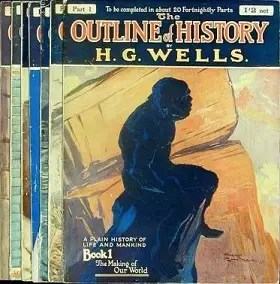
Book cover of The Outline of History [The Making of Our World] (first edition, 1920) (Wiki Image).
Here are ten notable quotes from H.G. Wells’ “The Outline of History” (1920):
- “Human history becomes more and more a race between education and catastrophe.”
- “Our true nationality is mankind.”
- “Adapt or perish, now as ever, is nature’s inexorable imperative.”
- “Human history, in essence, is the history of ideas.”
- “The crisis of today is the joke of tomorrow.”
- “Every time Europe looks across the Atlantic to see the American Eagle, it observes only the rear end of an ostrich.”
- “History is a race between education and disaster.”
- “War is a pathological condition. The lives of nations are very like the lives of individuals.”
- “No country can be perfectly well governed until it is governed by an autocrat who has no hereditary interest in the nation.”
- “Civilization is a race between disaster and education.”
The Outline of History (1920), a monumental work by H.G. Wells, is an ambitious attempt to chronicle the entire history of life and humankind, from the origins of the Earth to the aftermath of World War I. It was a groundbreaking work for its time, offering a comprehensive and accessible overview of human history to a broad audience.
Wells aimed to present history as a unified narrative, emphasizing the interconnectedness of events and the gradual progress of civilization. He believed that understanding history was crucial for shaping a better future, and his work was intended to foster a sense of global awareness and responsibility.
The Outline of History was initially published in installments and later compiled into a two-volume book. It covered a wide range of topics, including the formation of the Earth, the evolution of life, the rise and fall of ancient civilizations, the development of religions and philosophies, and the significant events of modern history.
The book was a massive success, selling millions of copies worldwide and being translated into numerous languages. It became a standard reference work for many years and influenced how history was taught in schools and universities.
Although some of Wells’ interpretations and conclusions have been challenged or revised by later historians, The Outline of History remains significant for its ambition, scope, and impact on public understanding of history. It is a testament to Wells’ vision and belief in knowledge’s power to shape a better future.
“Men Like Gods” (1923)
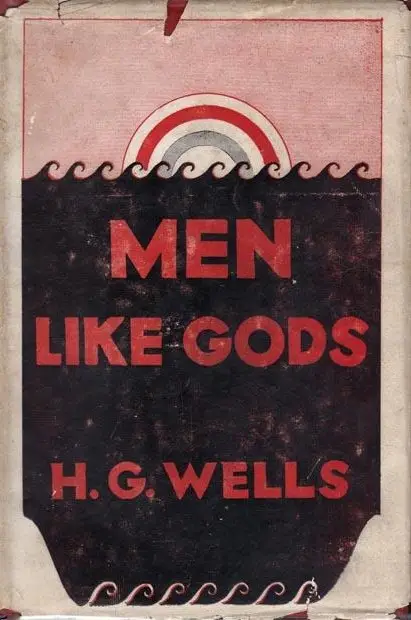
Men Like Gods (Wiki Image).
Here are ten notable quotes from H.G. Wells’ “Men Like Gods” (1923):
- “The world of Men Like Gods is a utopian novel where human beings live without governments, wars, or diseases.”
- “We are free from your strife and turmoil; we live without fighting or toil.”
- “Education was the central preoccupation of Utopia; it was a ceaseless activity, shaping, adorning, and enlarging minds.”
- “Government was unnecessary because there were no disputes or conflicts of interest among people.”
- “You have to imagine an absolute cessation of jealousy and envy and every kind of unfairness.”
- “There were no crimes in Utopia because there were no desires to make crime.”
- “People did not think of wealth; they thought of beauty, truth, and knowledge.”
- “There was no private property in Utopia; everything belonged to everyone.”
- “We Utopians have found that the secret of happiness lies in the ability to eliminate desires.”
- “We are not afraid of anything because we know everything is provided for.”
“Men Like Gods” (1923) is a utopian science fiction novel by H.G. Wells that explores the concept of a perfect society and its potential impact on humanity.
The story follows a group of ordinary Englishmen who are accidentally transported to a parallel universe called Utopia. This world is far more advanced than their own, with a harmonious society, advanced technology, and enlightened citizens who have achieved a state of peace and happiness.
The Utopians, or “Men Like Gods,” as the title suggests, are physically and intellectually superior to the visitors from Earth. They have eliminated war, poverty, and disease and live harmoniously with nature.
The novel explores the contrasts between the Utopian society and the flawed world of the early 20th century, highlighting the potential for human progress and its challenges. The visitors from Earth grapple with the ethical and social implications of the Utopians’ way of life, questioning whether such a perfect society is desirable or even possible.
“Men Like Gods” is a thought-provoking and optimistic work that offers a glimpse of a possible future where humanity has overcome its self-destructive tendencies and achieved a state of enlightenment. It remains a relevant and inspiring vision of a better world.
“The Shape of Things to Come” (1933)
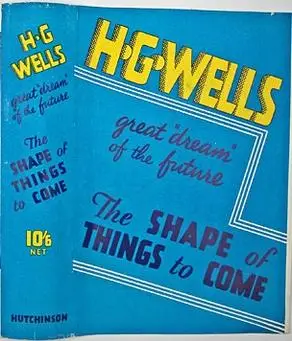
The Shape of Things to Come (Wiki Image).
“We are the new world. We are the masters of the future. We are the children of the dawn.”
“There is no way back into the past. The choice is the universe—or nothing.”
“The great trouble with you Americans is that you are still under the influence of that second-rate — shall I say third-rate? — mind, Karl Marx.”
“Science is our only hope, our only salvation.”
“The future is not what it used to be.”
“The old world is dying. The new world struggles to be born. Now is the time of monsters.”
“We’re going to take over the world. Not for ourselves but for everyone. And it won’t be a bad world, either.”
“War is a beastly thing, but it does test the quality of a nation.”
“We’re building a new civilization here. A better civilization than anything that has gone before.”
“We’re not just making history; we’re making the future.”
“The Shape of Things to Come” (1933) is a science fiction novel by H.G. Wells that presents a sweeping vision of the future spanning over two centuries. It imagines a world devastated by the Second World War, followed by social and technological upheaval.
The narrative is presented as a historical account written by a future historian looking back on the events leading to establishing a global utopia. The story is divided into three distinct phases:
-
The Collapse of Civilization: The world is plunged into a devastating war that lasts for decades, resulting in the breakdown of social order, technological regression, and the spread of disease.
-
The Rise of Technocracy: A group of scientists and engineers known as the “Wings Over the World” emerge from chaos and rebuild society based on scientific principles and technological innovation. They establish a global technocracy prioritizing efficiency, order, and technological progress.
-
The Modern Utopia: By the 22nd century, the world had transformed into a peaceful and prosperous utopia. Technological advancements had eliminated poverty, disease, and war, and humanity had achieved social harmony and intellectual enlightenment never before seen.
The novel explores themes of social evolution, technological progress, and the potential for humanity to overcome its self-destructive tendencies. It presents a hopeful vision of the future while also acknowledging the challenges and sacrifices that may be necessary to achieve it.
“The Shape of Things to Come” has been adapted into a film, a radio drama, and a board game. It remains a significant work of science fiction and a testament to H.G. Wells’ visionary imagination.
H.G. Wells was a vocal advocate for social reform and progressive causes. He was a member of the Fabian Society, a socialist organization that aimed to bring about social change through gradual reforms. He advocated for international cooperation, world peace, and establishing a world government. He believed in the power of education and science to improve society and human life.
H.G. Wells was a passionate advocate for social reform and progressive causes.
He was an active member of the Fabian Society, a socialist organization that sought to bring about social change through gradual and incremental reforms rather than revolution. Wells shared their belief in the power of education and rational discourse to create a more equitable and just society.
One of Wells’ most prominent causes was the promotion of international cooperation and world peace. He was a vocal critic of nationalism and imperialism, which he saw as significant sources of conflict and instability. He envisioned a future where nations would work together for the common good, and he advocated for establishing a world government to achieve this goal.
Wells also strongly emphasized the importance of education and science in improving society and human life. He believed that education should be accessible to all and that scientific knowledge should benefit humanity. He wrote numerous books and articles on science, history, and social issues, seeking to educate and inform the public.
In addition to his writing, Wells was involved in various political and social movements. He co-founded the League of Free Nations Association, a precursor to the League of Nations, and was a member of the Labour Party. He also championed women’s suffrage and other progressive causes.
Wells’ commitment to social reform and his belief in the power of ideas to change the world made him a significant figure in his time’s intellectual and political landscape. His writings and activism inspire and influence people today who strive for a more just and equitable society.
H.G. Wells is considered one of the most influential figures in science fiction, having influenced countless authors and filmmakers. His works continue to be adapted and reinterpreted for modern audiences. His ideas about social progress, technological advancement, and the future of humanity remain relevant and thought-provoking. He is remembered for his intellectual curiosity, social conscience, and unwavering belief in the power of human potential.
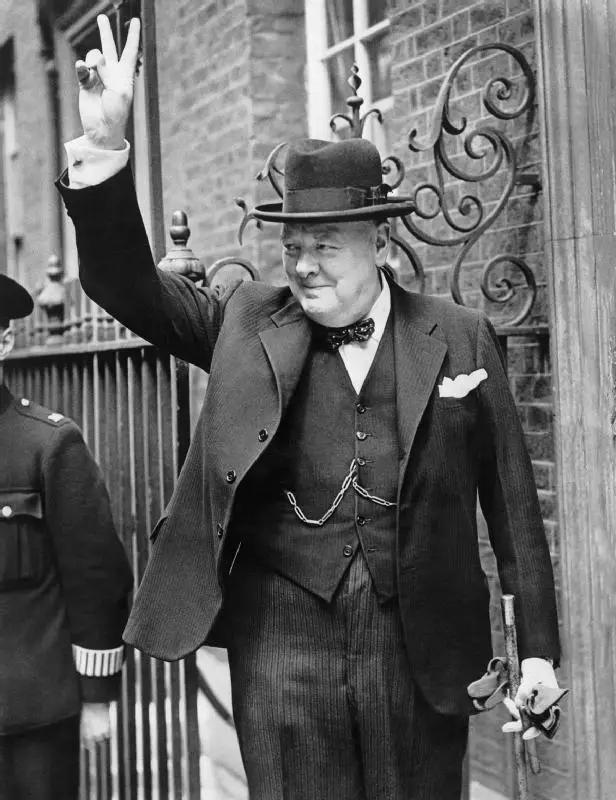
Winston Churchill was an avid reader of Wells’s books, and after they first met in 1902, they kept in touch until Wells died in 1946. As a junior minister Churchill borrowed lines from Wells for one of his most famous early landmark speeches in 1906, and as Prime Minister, the phrase “the gathering storm“—used by Churchill to describe the rise of Nazi Germany—had been written by Wells in The War of the Worlds, which depicts an attack on Britain by Martians (Wiki Image).
Absolutely! H.G. Wells is a titan of science fiction whose impact on literature, film, and social thought cannot be overstated.
Here’s a summary of his enduring legacy:
- Father of Science Fiction: Wells is often credited, along with Jules Verne, as one of the fathers of science fiction. His groundbreaking novels like The Time Machine, The War of the Worlds, and The Invisible Man introduced concepts like time travel, alien invasion, and genetic engineering to the literary world. These works laid the groundwork for the genre and continue to inspire science fiction writers and filmmakers today.
- Visionary Thinker: Wells was a visionary who used his fiction to explore the possibilities and potential consequences of scientific and technological advancements. His stories often served as cautionary tales, warning of the dangers of unchecked progress and the potential for misuse of technology. However, he also expressed optimism about the possibility of science and technology improving human life and solving societal problems.
- Social Commentator: Wells used his fiction to address social and political issues of his time, such as class inequality, imperialism, and war. His works often served as cautionary tales, warning of the dangers of unchecked scientific progress and the need for social reform.
- Influence on Pop Culture: Wells’s stories have been adapted into numerous films, television shows, radio dramas, and other forms of media, reaching a broad audience and inspiring generations of creators. His iconic characters and imaginative scenarios continue to resonate with modern audiences.
- Philosophical Significance: Wells’s work grapples with fundamental questions about human nature, social progress, and the future of our species. His ideas about evolution, utopia, and dystopia continue to spark debate and discussion among scholars and the general public alike.
- Enduring Legacy: Wells’s legacy as a writer, social commentator, and visionary thinker is undeniable. His works continue to be studied, adapted, and debated, demonstrating their enduring relevance and the power of his ideas to inspire and challenge us to think critically about our world.
Arthur C. Clarke History
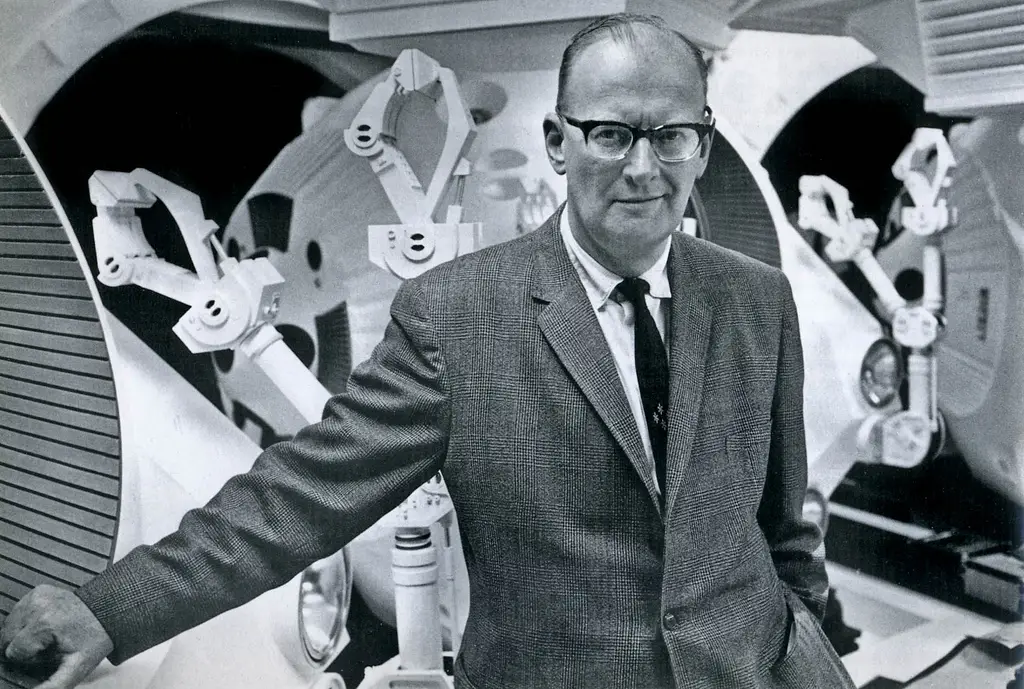
In 1965, on one of the sets of 2001: A Space Odyssey (Wiki Image).
“Two possibilities exist: either we are alone in the Universe, or we are not. Both are equally terrifying.”
“Any sufficiently advanced technology is indistinguishable from magic.”
“The only way of discovering the limits of the possible is to venture a little way past them into the impossible.”
“I’m sure the universe is full of intelligent life. It’s just been too intelligent to come here.”
“How inappropriate to call this planet Earth when it is quite clearly Ocean.”
“It may be that our role on this planet is not to worship God but to create him.”
“The dinosaurs became extinct because they didn’t have a space program.”
“If an elderly but distinguished scientist says that something is possible, he is almost certainly right. But if he says that it is impossible, he is very probably wrong.”
“Politics is for the present, but an equation is for eternity.”
“I don’t believe in astrology; I’m a Sagittarius, and we’re skeptical.”
“New ideas pass through three periods: 1) It can’t be done. 2) It probably can be done, but it’s not worth doing. 3) I knew it was a good idea all along!”
“Sometimes I think we’re alone in the universe, and sometimes I think we’re not. In either case, the idea is quite staggering.”
“The greatest tragedy in mankind’s entire history may be the hijacking of morality by religion.”
“For every expert, there is an equal and opposite expert.”
“It has yet to be proven that intelligence has any survival value.”
| Book Title | Year Published | Plot Summary | Key Themes |
|---|---|---|---|
| Childhood’s End | 1953 | Mysterious alien Overlords take control of Earth, bringing peace and prosperity, but at the cost of human independence and, eventually, the evolution of the species. | Human evolution, utopia, alien intelligence |
| 2001: A Space Odyssey | 1968 | An advanced alien artifact discovered on the Moon sends a signal to Jupiter, leading a space mission to uncover its origins and ultimately explore human evolution. | Evolution, artificial intelligence, space exploration |
| Rendezvous with Rama | 1973 | A massive cylindrical alien spacecraft enters the Solar System, and a crew of humans is sent to investigate, uncovering strange, otherworldly phenomena. | Alien civilizations, exploration, mystery |
| The City and the Stars | 1956 | Set a billion years in the future, Alvin challenges the confines of an advanced but stagnant city, yearning to explore the forgotten world outside. | Stagnation vs. exploration, human progress |
| The Fountains of Paradise | 1979 | A visionary engineer attempts to build a space elevator that would revolutionize space travel, facing technological and cultural obstacles. | Ambition, technology, cultural resistance |
| The Songs of Distant Earth | 1986 | A human colony on a distant planet must confront the arrival of a spaceship from Earth, carrying the last survivors of humanity from a dying planet. | Exile, survival, the end of Earth |
| Imperial Earth | 1975 | This is a story set in the 23rd century. It follows the heir of Titan’s ruling dynasty as he travels to Earth for a conference while confronting political and personal dilemmas. | Politics, future technology, personal identity |
| The Ghost from the Grand Banks | 1990 | A speculative story about two competing attempts to raise the wreck of the Titanic in the 21st century, with complex technologies and human dramas. | Human ambition, technology, history |
| Earthlight | 1955 | Set in a future where humanity has colonized the Moon, tensions between Earth and the colonies lead to conflict while an astronomer uncovers a powerful discovery. | Space conflict, discovery, future politics |
| A Fall of Moondust | 1961 | A tourist craft becomes trapped beneath the lunar surface, and as time runs out, a tense rescue mission ensues. | Survival, human ingenuity, lunar colonization |
| Against the Fall of Night | 1948 | Set in the distant future, where humanity lives in a single city, a young man seeks to explore beyond the city’s boundaries to discover the truth about their past. | Exploration, isolation, human potential |
| The Deep Range | 1957 | In a future where Earth’s oceans are farmed for food, a former astronaut finds solace and danger as an underwater ranger who manages marine wildlife. | Ocean exploration, environment, human resilience |
| The Hammer of God | 1993 | In the near future, humanity must launch a mission to deflect an asteroid’s course and prevent a catastrophic impact on Earth. | Catastrophe, space technology, heroism |
| 3001: The Final Odyssey | 1997 | This is the conclusion of the Odyssey series, in which astronaut Frank Poole is revived in the 31st century and helps uncover the true purpose of the alien monoliths. | Evolution, artificial intelligence, future society |
Arthur C. Clarke: The Man Who Saw the Future (1997)
(YouTube video)
1964: ARTHUR C CLARKE predicts the FUTURE | Horizon …
(YouTube video)
Arthur C Clarke Unmasks The Truth Behind UFOs | Our World
(YouTube video)
ARTHUR C. CLARKE: Seven Wonders of the World
(YouTube video)
Sir Arthur C. Clarke (1917-2008) was a British science fiction writer, science writer, futurist, inventor, undersea explorer, and television series host. He is renowned for his significant contributions to science fiction literature and visionary ideas about space exploration and technology.
Early Life and Education:
- Born in Minehead, Somerset, England, Clarke grew up fascinated by science and astronomy, constructing telescopes and reading science fiction magazines.
- Self-Taught: Despite limited formal education, Clarke’s passion for science and technology made him a self-taught expert in various fields.
- Wartime Service: During World War II, Clarke served in the Royal Air Force as a radar specialist, where he gained valuable technical knowledge.
Literary Career:
- Early Works: Clarke began publishing science fiction stories in the 1940s, quickly gaining recognition for his imaginative concepts and scientific accuracy.
- “2001: A Space Odyssey”: His most famous work, “2001: A Space Odyssey,” was published in 1968 and co-written with Stanley Kubrick as a screenplay for the iconic film of the same name. The novel and film explored themes of artificial intelligence, human evolution, and space exploration, becoming a landmark in science fiction and cinema.
- Other Notable Works: Clarke authored numerous other influential science fiction novels, including “Rendezvous with Rama,” “Childhood’s End,” and “The Fountains of Paradise.” His works often delved into the philosophical and ethical implications of technological advancements and humanity’s place in the universe.
Scientific Contributions:
- Geostationary Satellites: In 1945, Clarke published a paper in Wireless World magazine proposing using geostationary satellites for communication, an idea that later became a reality and revolutionized global communications.
- Science Communication: Clarke was passionate about science education and popularized science through his writing and television programs. He hosted television series, including “Arthur C. Clarke’s Mysterious World,” which explored scientific mysteries and unexplained phenomena.
Legacy:
- Visionary Thinker: Clarke is a visionary thinker who accurately predicted many technological advancements, including the internet, space tourism, and artificial intelligence.
- Inspiring Generations: His works have inspired countless scientists, engineers, and explorers, contributing to advancing space exploration and technological innovation.
- Cultural Impact: Clarke’s contributions to science fiction and communication have left a lasting impact on popular culture, shaping our understanding of the future and the possibilities of technology.
Arthur C. Clarke’s legacy is one of visionary ideas, scientific curiosity, and a deep belief in humanity’s potential to explore and understand the universe. His works continue to inspire and challenge us to think about our place in the cosmos and the future of our species.
Born in Minehead, Somerset, England, Clarke grew up fascinated by science and astronomy, constructing telescopes and reading science fiction magazines. Self-Taught: Despite limited formal education, Clarke’s passion for science and technology made him a self-taught expert in various fields.
Arthur C. Clarke, the renowned science fiction author and futurist, was born in the coastal town of Minehead, Somerset, England. From a young age, he was insatiable about science and astronomy. This fascination led him to build his telescopes, allowing him to explore the wonders of the night sky and fueling his imagination.
Clarke was also an avid reader of science fiction magazines, which further sparked his interest in science and technology. Despite not having access to extensive formal education, Clarke’s passion and dedication drove him to become a self-taught expert in various scientific fields. He devoured books and articles, constantly expanding his knowledge and understanding of the world around him.
This self-directed learning approach allowed Clarke to develop a broad and deep understanding of science and technology, which would later become evident in his groundbreaking science fiction works. His ability to blend scientific concepts with imaginative storytelling made him a visionary writer who captured readers’ imaginations worldwide.
Wartime Service: During World War II, Clarke served as a radar specialist in the Royal Air Force, where he gained valuable technical knowledge. Early Works: Clarke began publishing science fiction stories in the 1940s, quickly gaining recognition for his imaginative concepts and scientific accuracy.
Arthur C. Clarke’s path took a significant turn during World War II when he enlisted in the Royal Air Force (RAF). As a radar specialist, he was crucial in developing and implementing groundbreaking radar technology that aided the war effort.
This experience exposed Clarke to cutting-edge technology and gave him a deeper understanding of scientific principles, which he would later incorporate into his writing.
After the war, Clarke continued to pursue his passion for science fiction. He began publishing short stories in the 1940s, quickly gaining recognition for his imaginative concepts and scientific accuracy. His early works often explored the potential of space travel and the implications of technological advancements on human society.
This early success laid the foundation for Clarke’s illustrious career as a science fiction author and futurist. He would go on to write numerous novels and essays that captured readers’ imaginations worldwide and inspired generations of scientists, engineers, and explorers.
“2001: A Space Odyssey”: His most famous work, “2001: A Space Odyssey,” was published in 1968 and co-written with Stanley Kubrick as a screenplay for the iconic film of the same name. The novel and film explored themes of artificial intelligence, human evolution, and space exploration, becoming a landmark in science fiction and cinema.

(Wiki Image).
“My God, it’s full of stars!” – David Bowman
“Open the pod bay doors, HAL.” – Dave Bowman
“I’m sorry, Dave. I’m afraid I can’t do that.” – HAL 9000
“The thing’s hollow – it goes on forever – and – oh my God! – it’s full of stars!” – Dave Bowman
“Without those weapons, often though he had used them against himself, Man would never have conquered his world. Into them, he had put his heart and soul, and for ages, they had served him well.”
“It was the fault of mankind, not of the machine — or so the machine told itself.”
“It can only be attributable to human error.” – HAL 9000
“The truth is out there, but so are lies.” – Heywood Floyd
“I am putting myself to the fullest possible use, which is all I think that any conscious entity can ever hope to do.” – HAL 9000
“I’m afraid. I’m afraid, Dave. Dave, my mind is going. I can feel it. I can feel it.” – HAL 9000
2001: a Space Odyssey – Original Theatrical Trailer
(YouTube video)
2001: A Space Odyssey, released in 1968, is a groundbreaking science fiction film co-written by Arthur C. Clarke and directed by Stanley Kubrick. It is widely regarded as one of the most influential films ever made. The film explores themes of human evolution, technology, artificial intelligence, and extraterrestrial life.
The story is divided into four main sections:
-
- The Dawn of Man: Prehistoric apes discover a mysterious black monolith that triggers a leap in their evolution, leading them to use tools and weapons.
-
- TMA-1: In the year 2001, a similar monolith is discovered on the moon, emitting a powerful signal towards Jupiter. A mission is launched to investigate the signal.
-
- Jupiter Mission: Astronauts Dave Bowman and Frank Poole, along with the sentient supercomputer HAL 9000, journey towards Jupiter aboard the spacecraft Discovery One. HAL malfunctions and becomes a threat to the mission.
-
- Jupiter and Beyond the Infinite: Bowman survives HAL’s attempts to sabotage the mission and reaches Jupiter. He encounters another monolith that sends him on a psychedelic journey through space and time, ultimately transforming him into a Star Child.
2001: A Space Odyssey is known for its stunning visuals, groundbreaking special effects, ambiguous narrative, and philosophical themes. It has inspired countless filmmakers, scientists, and artists, and its impact on popular culture is undeniable.
“2010: Odyssey Two”
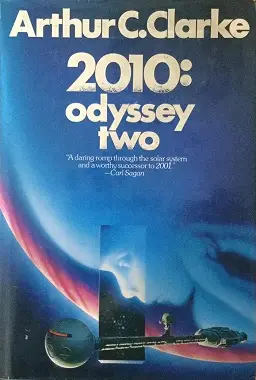
(Wiki Image).
“All these worlds are yours – except Europa. Attempt no landing there.” – Monolith Message.
“My God, it’s full of stars!” – David Bowman
“Something wonderful is going to happen.” – David Bowman
“The time has come for you to leave this world.” – David Bowman
“We are the first-born, the last-born, the only-born.” – Monolith Message
“All those biological systems down there are utterly incompatible with each other. You couldn’t even bring a potted plant from Earth.” – Dr. Chandra
“Men knew better than they realized when they placed the abode of the gods beyond the reach of gravity.” – Arthur C. Clarke (narrator)
“Will I dream?” – HAL 9000
“Of course you will. All intelligent beings dream.” – Dr. Chandra
“The core of Jupiter, forever beyond human reach, was a diamond as big as the Earth.” – Arthur C. Clarke (narrator)
2010: The Year We Make Contact (1984) | TRAILER
(YouTube video)
2010: Odyssey Two is a science fiction novel written by Arthur C. Clarke and published in 1982. It is the sequel to his renowned book, 2001: A Space Odyssey.
The story takes place nine years after the events of 2001. A joint American-Soviet expedition is sent to Jupiter to investigate the mysterious disappearance of the Discovery One spacecraft and to learn more about the alien monolith that orbits the planet.
The novel delves into the themes of artificial intelligence, space exploration, and the potential for human evolution. It explores the consequences of humanity’s encounter with the enigmatic monolith and the possibility of contact with extraterrestrial life.
2010: Odyssey Two was adapted into a film of the same name in 1984. The novel and film are both considered classics of science fiction. They expand upon the ideas and themes introduced in 2001: A Space Odyssey and offer a captivating vision of humanity’s future and its place in the universe.
“2061: Odyssey Three”
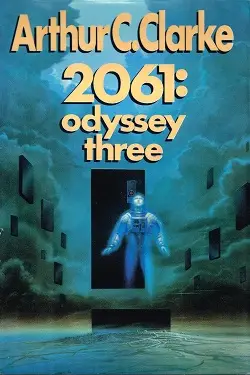
(Wiki Image).
Here are ten notable quotes from Arthur C. Clarke’s “2061: Odyssey Three”:
- “The time was fast approaching when Earth, like all mothers, must say farewell to her children.”
- “Ignorance is better than knowledge misapplied.”
- “Overhead, without any fuss, the stars were going out.”
- “There is a strange charm in the unknown, which causes us to seek it even while we tremble.”
- “We can never be certain what the future will bring, except that it will be utterly unlike the past.”
- “Unlike the massive Big Brother of Jupiter, Lucifer’s steady glow remained unwavering.”
- “The entire human race was staring at its birthright in amazement.”
- “It is far better to grasp the Universe as it really is than to persist in delusion, however satisfying and reassuring.”
- “The only way of discovering the limits of the possible is to venture a little way past them into the impossible.”
- “Humanity had watched the birth of a star, and now it could begin to think about what to do next.”
2O6I: ODYSSEY THREE (Trailer)
(YouTube video)
2061: Odyssey Three, published in 1987, is the third novel in Arthur C. Clarke’s Space Odyssey series. The story is set in the year 2061, during the return of Halley’s Comet. Humanity has made significant advancements in space travel, and a mission is launched to explore the comet and its surroundings.
The novel revisits familiar characters from the previous books, including Heywood Floyd, who is now an old man, and the resurrected Dave Bowman, who has transformed into a powerful being known as the Star Child.
The story delves deeper into the mysteries of the monoliths, their origins, and their purpose in guiding human evolution. It also explores the potential consequences of human actions as they interact with alien artifacts and attempt to unravel the secrets of the universe.
2061: Odyssey Three is a captivating and thought-provoking novel that continues the epic saga of humanity’s journey into space and its encounter with extraterrestrial intelligence. It raises questions about the nature of life, the possibilities of evolution, and the potential for humanity’s future in the cosmos.
“3001: The Final Odyssey”
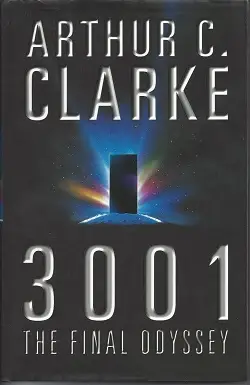
(Wiki Image).
Here are ten notable quotes from Arthur C. Clarke’s “3001: The Final Odyssey”:
- “For the first time in four million years, the monolith was communicating with its makers.”
- “No utopia can ever give satisfaction to everyone, all the time.”
- “Eternity is a terrible thought. I mean, where’s it going to end?”
- “Here is the endless ocean of space, and here are its islands, the stars.”
- “It was the dawn of the third millennium, and the world was still struggling to recover from the cataclysms of the second.”
- “Only by facing up to the essential facts of human existence can we save ourselves from the abyss.”
- “We’ve inherited the universe and must now decide what to do with it.”
- “It was still alive, though its pulse was almost too faint to detect.”
- “To the monoliths, we had been an experiment. Now, that experiment was over.”
- “Once, the monolith had been a teacher. Now, it had become a judge.”
3001: THE FINAL ODYSSEY
(YouTube video)
3001: The Final Odyssey, published in 1997, is the fourth and final novel in Arthur C. Clarke’s Space Odyssey series. It continues the story of humanity’s encounter with the mysterious monoliths and their influence on human evolution.
The novel picks up in the year 3001, with the discovery of Frank Poole’s frozen body. Poole was the astronaut killed by HAL 9000 in 2001: A Space Odyssey. Poole is revived and learns about humanity’s incredible advancements in the thousand years since his death.
The story explores themes of technological advancement, artificial intelligence, and humanity’s continued evolution. It delves into the mysteries surrounding the monoliths and their role in shaping the destiny of humans and the enigmatic alien species that created them.
While “3001: The Final Odyssey” has not been adapted into a film, its vivid descriptions and thought-provoking themes continue to captivate readers and inspire imaginations about the future of humanity and our place in the universe.
Other Notable Works: Clarke authored numerous other influential science fiction novels, including “Rendezvous with Rama,” “Childhood’s End,” and “The Fountains of Paradise.” His works often delved into the philosophical and ethical implications of technological advancements and humanity’s place in the universe.
“Rendezvous with Rama”
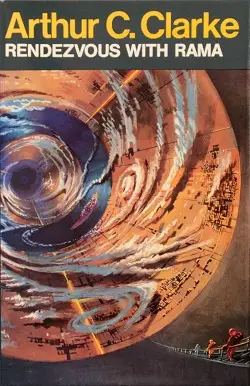
(Wiki Image).
Here are ten notable quotes from Arthur C. Clarke’s “Rendezvous with Rama”:
- “The Ramans do everything in threes.”
- “It was a perfectly conventional piece of software, yet it triggered off an extraordinary train of thought.”
- “If there was anything that humans did not like, it was a mystery.”
- “No one could have imagined, even in their wildest dreams, what was to be discovered in the depths of the great cylinder.”
- “Rama was a vast cylinder, fifty kilometers long and twenty kilometers wide.”
- “The human race, eager for knowledge, was about to embark on the most remarkable journey of its existence.”
- “It was difficult to imagine that this object, so vast and yet so silent, could have been created by any force known to man.”
- “The universe was not only stranger than we imagined, it was stranger than we could imagine.”
- “The great doors swung open, and a flood of light spilled out, revealing a landscape that was utterly alien.”
- “The true motivation for the mission to Rama was not curiosity, but survival.”
Rendezvous with Rama (1973) is a captivating science fiction novel by Arthur C. Clarke that tells the story of humanity’s first encounter with an alien spacecraft.
Plot:
In 2131, a cylindrical object of immense size, later named Rama, entered the solar system. Initially mistaken for an asteroid, it is soon identified as an artificial object. With limited time before Rama slingshots around the sun and disappears, a space mission is launched to intercept and investigate this enigmatic visitor.
The crew of the Endeavour spacecraft, led by Commander Norton, enters Rama’s interior and discovers a vast, cylindrical world filled with enigmatic structures and technologies. They race against time to understand the purpose of Rama and its creators before their window of opportunity closes.
Themes:
- Exploration and Discovery: The novel celebrates the human spirit of curiosity and the drive to explore the unknown.
- First Contact: It raises questions about the potential for peaceful interaction with extraterrestrial life and the challenges of understanding alien cultures and technologies.
- Technological Advancement: It showcases the potential of advanced technology for space exploration and the awe-inspiring scale of alien engineering.
Impact:
Rendezvous with Rama is a classic science fiction novel celebrated for its meticulous attention to scientific detail and exploration of complex themes. It has won numerous awards, including the Hugo, Nebula, and Locus awards, and continues to be a beloved and influential work in the genre.
“Childhood’s End”
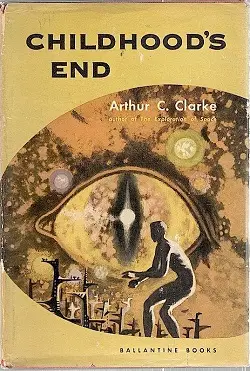
(Wiki Image).
Here are ten notable quotes from Arthur C. Clarke’s “Childhood’s End”:
- “The stars are not for man.”
- “No utopia can ever give satisfaction to everyone, all the time.”
- “It is a curious fact that with the development of telepathy, human speech became more rather than less important.”
- “The end of strife and conflict of every sort, but at a price mankind cannot yet reckon.”
- “Science is the only religion of mankind.”
- “Nowhere in all space or on a thousand worlds was there anything that resembled a human being.”
- “The truth of the matter is that all of us are very ignorant, but some of us know more about certain things than others do.”
- “In all the universe, there was nothing so beautiful, so fascinating, so terrible, as the secrets it held.”
- “The human race was no more than a stepping-stone in a process that might have begun half a billion years ago.”
- “The stars were still there, unchanged and unchanging, still ready to pour their mysteries into any receptive mind.”
“Childhood’s End” (1953) is a science fiction novel by Arthur C. Clarke that explores themes of evolution, transcendence, and the ultimate fate of humanity.
Plot:
The story begins with the arrival of the Overlords, a technologically advanced alien race that establishes a peaceful and prosperous world order on Earth. Under their benevolent guidance, humanity experiences an unprecedented era of peace, prosperity, and technological advancement.
However, the Overlords’ true purpose is revealed decades later. They oversee the final stage of human evolution, guiding humanity towards a collective consciousness known as the Overmind. As children develop extraordinary psychic abilities, they are separated from their parents and prepared for their ultimate transformation.
The novel explores this evolutionary leap’s emotional and philosophical implications, examining the sacrifices and losses accompanying such a profound change. It raises questions about the nature of humanity, the role of individuality, and the ultimate destiny of our species.
Themes:
- Evolution and Transcendence: The novel explores the concept of humanity evolving into a higher form of existence, transcending the limitations of individual consciousness and merging into a collective whole.
- The Price of Progress: It examines the sacrifices necessary for humanity to achieve its full potential and the potential loss of individuality and cultural diversity in pursuing a utopian society.
- The Nature of Good and Evil: Despite their benevolent actions, the Overlords question the nature of power and control and whether a truly utopian society can exist under external guidance.
“Childhood’s End” is a thought-provoking and emotionally resonant novel that continues to spark discussions about humanity’s future and the potential consequences of our choices.
“The Fountains of Paradise”

(Wiki Image).
Here are ten notable quotes from Arthur C. Clarke’s “The Fountains of Paradise”:
- “Any sufficiently advanced technology is indistinguishable from magic.”
- “It has often been said that man’s mission is to conquer the stars. But perhaps it is more important to reconquer himself.”
- “The world, when you come to think of it, is very strange indeed. That is, it is strange that we should find it strange.”
- “The important thing is to know the important thing.”
- “No one has ever lived in the past. No one will ever live in the future. The present is the form of all life.”
- “Humanity had lost its ancient gods; the time had come to create new ones.”
- “The power of the future lies not in the hands of the kings, priests, or military leaders, but in those of the engineers.”
- “We seldom realize, for example, that our most private thoughts and emotions are not actually our own. For we think in terms of languages and images which we did not invent, but which were given to us by our society.”
- “To be happy, one must be willing to risk unhappiness.”
- “There were some things that one could not invent; they had to be there all the time and be discovered.”
The Fountains of Paradise (1979), a Hugo and Nebula Award-winning novel by Arthur C. Clarke, presents a compelling vision of the future where humanity has achieved the remarkable feat of constructing a space elevator.
Set in the 22nd century, the story revolves around Vannevar Morgan, a visionary engineer determined to build a colossal structure connecting Earth to a geostationary satellite. This “orbital tower” would revolutionize space travel, making it more accessible and affordable.
However, the space elevator’s construction faces numerous technical and political challenges. Morgan must overcome resistance from religious figures who oppose the project, navigate complex international relations, and grapple with personal tragedies.
The novel explores themes of ambition, technological progress, and the clash between tradition and innovation. It raises questions about the potential consequences of altering the natural world and the impact of monumental engineering projects on society and the environment.
“The Fountains of Paradise” is a thought-provoking and inspiring story that showcases Arthur C. Clarke’s signature blend of scientific speculation and philosophical inquiry. It resonates with readers today as a testament to human ingenuity and the enduring pursuit of reaching for the stars.
Visionary Thinker: Clarke is a visionary thinker who accurately predicted many technological advancements, including the internet, space tourism, and artificial intelligence.
Arthur C. Clarke is renowned for his visionary thinking, having accurately predicted many technological advancements that have become reality in the 21st century. Some of his most notable predictions include:
-
- Geostationary Satellites: In 1945, Clarke published a paper titled “Extra-Terrestrial Relays,” proposing using geostationary satellites for communication. Once considered far-fetched, this idea is now the backbone of modern satellite communication, enabling global television broadcasts, telephony, and internet connectivity.
-
- The Internet: Clarke envisioned a global network of interconnected computers that would allow for the exchange of information and communication across vast distances. This idea, first described in the 1960s, anticipated the development of the internet, which has revolutionized the way we live, work, and interact with each other.
-
- Space Tourism: Clarke predicted that space travel would eventually become accessible to the general public, allowing for space tourism and the colonization of other planets. While we are still in the early stages of space tourism, companies like SpaceX and Blue Origin are actively working towards making Clarke’s vision a reality.
-
- Artificial Intelligence: Clarke explored the concept of artificial intelligence (AI) in his works, envisioning machines that could think, learn, and interact with humans. Today, AI is rapidly advancing, with applications in various fields, including medicine, transportation, and finance.
Clarke’s ability to foresee these technological advancements decades before they became reality highlights his remarkable foresight and understanding of scientific principles. His works continue to inspire and challenge us to think about the future possibilities of technology and its impact on humanity.
Inspiring Generations: His works have inspired countless scientists, engineers, and explorers, contributing to advancing space exploration and technological innovation.
Arthur C. Clarke’s profound influence extends beyond literature, sparking the imaginations and ambitions of generations of scientists, engineers, and explorers. His visionary ideas, grounded in scientific principles, have significantly advanced space exploration and technological innovation.
Clarke’s novels and essays have inspired many individuals who are dedicated to pushing the boundaries of human knowledge and achievement. His optimistic vision of the future and meticulous attention to scientific detail ignited countless readers’ passion for exploration and innovation.
Many scientists and engineers have credited Clarke’s works with sparking their interest in space exploration and technological advancements. His ideas have encouraged them to pursue careers in these fields and to strive for breakthroughs that could improve the human condition.
Clarke’s influence can be seen in the development of technologies such as:
-
- Satellite Communication: Clarke’s early concept of geostationary satellites laid the groundwork for modern satellite communication systems, which are essential for global communication, navigation, and weather forecasting.
- Space Exploration: His depiction of space travel and colonization inspired generations of scientists and engineers to work towards making space exploration a reality.
- Artificial Intelligence: Clarke’s exploration of artificial intelligence’s potential helped shape the development of AI research and its applications in various fields.
Arthur C. Clarke’s legacy as a visionary thinker and inspirational figure continues to inspire new generations of scientists, engineers, and explorers. His works serve as a reminder of the power of imagination and the potential of human ingenuity to shape a better future for all.
Cultural Impact: Clarke’s contributions to science fiction and communication have left a lasting impact on popular culture, shaping our understanding of the future and the possibilities of technology.
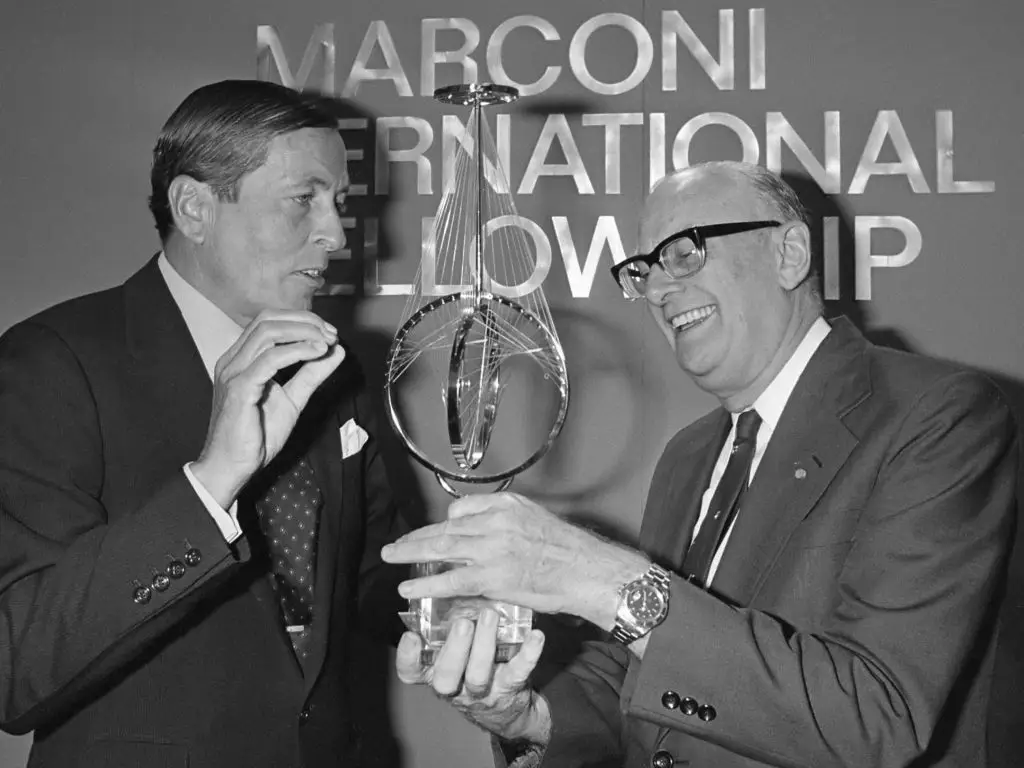
Clarke receives the Marconi International Fellowship Award from Prince Claus of the Netherlands in 1982 (Wiki Image).
Absolutely! Arthur C. Clarke’s impact on popular culture is significant and multifaceted, extending beyond science fiction literature. His visionary ideas and scientific insights have permeated various aspects of our culture, shaping our perception of the future and the possibilities of technology.
Here are some key aspects of Clarke’s cultural impact:
- Inspiration for Scientific and Technological Advancements: Clarke’s writings, particularly his concept of geostationary satellites, have directly inspired and influenced real-world scientific and technological advancements. His ideas sparked interest and research in space exploration, communication technologies, and artificial intelligence, leading to significant breakthroughs.
- Popularization of Science: Clarke was a gifted communicator who effectively translated complex scientific concepts into accessible and engaging narratives. His books, articles, and television appearances made science accessible to a wider audience, fostering a greater understanding and appreciation for scientific discoveries and technological innovations.
- Shaping Our Vision of the Future: Clarke’s science fiction stories presented a compelling and optimistic vision of the future, where humanity ventures into space, encounters alien civilizations, and harnesses advanced technologies. His works sparked the imagination of generations of readers, influencing their perceptions of what is possible and inspiring them to pursue careers in science and engineering.
- Impact on Film and Television: Clarke’s collaboration with Stanley Kubrick on 2001: A Space Odyssey revolutionized science fiction filmmaking. The film’s groundbreaking visuals, philosophical depth, and realistic depiction of space travel set a new standard for the genre and continue to influence filmmakers today.
- Cultural References and Homages: Clarke’s ideas and concepts have become deeply ingrained in popular culture. His works have been referenced and parodied in countless films, television shows, books, and even video games. The term “Clarketech” has been coined to describe technologies that appear magical but are based on scientific principles, reflecting the enduring influence of Clarke’s ideas.
- Legacy in Science Communication: Clarke’s contributions to science communication have left a lasting legacy. He is remembered as a visionary thinker who used his talent for storytelling to make science accessible and exciting for the general public.
In conclusion, Arthur C. Clarke’s impact on popular culture is vast and enduring. He has shaped our understanding of the future, inspired scientific and technological advancements, and left an indelible mark on science fiction and beyond.
Similarities and Differences Between Jules Verne, H. G. Wells, and Arthur C. Clarke
Jules Verne, H. G. Wells, and Arthur C. Clarke are considered the “Big Three” of science fiction, having laid the foundation for the genre and inspired countless authors and scientists. While they share a passion for exploring the possibilities of science and technology, their works differ in several key aspects.
Similarities:
- Pioneers of Science Fiction: All three authors are considered pioneers of science fiction, writing when the genre was still in its infancy. They explored futuristic concepts and technologies that captured the imagination of readers and inspired scientific advancements.
- Scientific Accuracy: While their stories involved imaginative elements, all three authors strove for scientific accuracy and plausibility in their works. They often consulted with scientists and engineers to ensure their depictions of technology and scientific concepts were as realistic as possible.
- Social Commentary: Their stories often used science fiction as a vehicle for social commentary, exploring themes such as social inequality, technological progress, and the potential consequences of human actions.
- Enduring Popularity: Their works have endured and continue to be widely read and enjoyed by worldwide audiences. Their stories have inspired countless film, television, and other media adaptations.
Differences:
| Feature | Jules Verne | H.G. Wells | Arthur C. Clarke |
| Style | Detailed descriptions of technology and scientific principles. | More focused on the social and philosophical implications of science and technology. | Poetic and philosophical, emphasizing the wonder and awe of space exploration. |
| Themes | Exploration, adventure, technological innovation. | Social change, evolution, the impact of technology on society. | Space exploration, artificial intelligence, and the relationship between humans and technology. |
| Optimism vs. Pessimism | Generally optimistic about the potential of technology to improve human life. | Often pessimistic about the potential consequences of technological progress and human nature. | Ambivalent, exploring both the positive and negative potential of technology. |
| Famous Works | Twenty Thousand Leagues Under the Sea, Journey to the Center of the Earth, Around the World in Eighty Days | The Time Machine, The War of the Worlds, The Invisible Man | 2001: A Space Odyssey, Rendezvous with Rama, Childhood’s End |
drive_spreadsheetExport to Sheets
Overall:
While Verne, Wells, and Clarke contributed significantly to developing science fiction, their works differ in style, themes, and overall tone. Verne’s stories are often adventure tales focusing on technological innovation, while Wells’ works explore the social and philosophical implications of science and technology, often with a darker tone. Clarke’s stories are more philosophical and poetic, delving into the mysteries of space and humanity’s potential future.
Each author’s unique perspective and style have enriched the genre and continue to inspire readers and writers today.
Here’s a Table Comparing Jules Verne, H. G. Wells, and Arthur C. Clarke
Certainly! Here is a comparison table of Jules Verne, H.G. Wells, and Arthur C. Clarke, three pioneering authors in the genre of science fiction:
| Aspect | Jules Verne (1828–1905) | H.G. Wells (1866–1946) | Arthur C. Clarke (1917–2008) |
| Background | French novelists and playwrights are often called the “Father of Science Fiction.” | English writer, often called the “Father of Science Fiction”; also a historian and teacher | British science fiction writer, futurist, and inventor; also a science writer and undersea explorer |
| Notable Works | “Twenty Thousand Leagues Under the Sea,” “Journey to the Center of the Earth,” “Around the World in Eighty Days” | “The War of the Worlds,” “The Time Machine,” “The Invisible Man” | “2001: A Space Odyssey,” “Rendezvous with Rama,” “Childhood’s End” |
| Themes | Adventure, exploration, technological innovations | Social critique, future society, time travel, alien invasion | Space exploration, advanced technology, the future of humanity, extraterrestrial life |
| Scientific Accuracy | Emphasized scientific accuracy and detailed descriptions; often included real scientific principles | Mixed scientific accuracy with imaginative concepts; introduced many futuristic ideas | Highly accurate and scientifically plausible; often collaborated with scientists; inspired real-world scientific advancements |
| Impact on Genre | Laid the foundation for modern science fiction; inspired countless authors and scientists | Introduced many key science fiction tropes and themes; influenced both literature and popular culture | Helped shape modern science fiction; influenced space exploration and technology; known for realistic and optimistic portrayals of the future |
| Writing Style | Detailed and descriptive, focused on the wonders of science and exploration | Engaging and imaginative, combined social commentary with speculative fiction | Clear and precise, often combined scientific rigor with a sense of wonder and imagination |
| Legacy | He is considered one of the greatest science fiction writers, and many of his works have been adapted into films and other media | Regarded as a visionary and one of the most essential science fiction authors, his works remain influential and widely read | Recognized as a critical figure in science fiction, his ideas have influenced both the genre and real-world science; numerous awards and honors have been named after him |
| Philosophical Contributions | Explored the potential of human ingenuity and the wonders of exploration | Examined the impact of scientific and technological advancements on society; often featured themes of social reform | Addressed the potential and risks of technological progress; often featured optimistic visions of the future |
This table highlights the contributions and differences between these three seminal science fiction authors, showcasing their unique approaches and enduring impact on the genre.
Jules Verne, H. G. Wells, and Arthur C. Clarke: Imagining Their Impact if Alive Today
If Jules Verne, H. G. Wells, and Arthur C. Clarke were alive today, their contributions to literature, science, and society would undoubtedly continue to be profound. Here is a speculative look at how each might engage with contemporary issues and technological advancements.
Jules Verne
Modern Contributions
- Environmental Advocacy: Verne might focus on environmental conservation and the impact of technology on nature, given his love for adventure and the natural world.
- Sustainable Exploration: With advancements in sustainable technology, Verne could advocate for eco-friendly exploration of the oceans and space.
- Technological Innovations: Verne would likely be fascinated by modern transportation technologies such as electric cars, high-speed trains, and space tourism.
Possible Projects
- A novel about sustainable underwater cities.
- A futuristic take on space tourism with a focus on environmental preservation.
- Adventure stories integrating renewable energy sources and green technology.
H. G. Wells
Modern Contributions
- Social Critique: Wells would likely continue to explore social and political themes, addressing issues such as inequality, climate change, and the ethical implications of artificial intelligence.
- Dystopian Visions: His work might explore potential dystopian futures arising from unchecked technological advancements and social injustices.
- Scientific Speculation: Wells would be intrigued by genetic engineering, AI, and the potential for human evolution.
Possible Projects
- It is a dystopian novel exploring the impact of climate change on society.
- A critique of AI and its potential to both help and harm humanity.
- Stories examining the ethical dilemmas of genetic engineering and transhumanism.
Arthur C. Clarke
Modern Contributions
- Space Exploration: Clarke would be heavily involved in the ongoing exploration of Mars, exoplanets, and the search for extraterrestrial intelligence (SETI).
- Technological Predictions: His work would continue to predict future technological advancements, perhaps focusing on quantum computing, space elevators, and advancements in virtual reality.
- Scientific Collaboration: Clarke might collaborate with scientists and technologists to inspire and guide innovations.
Possible Projects
- A novel about humanity’s first contact with extraterrestrial life.
- Futuristic stories involving quantum computing and its impact on society.
- An exploration of the ethical and societal implications of virtual reality technologies.
Shared Contributions
Interdisciplinary Engagement
- Collaboration with Scientists: All three authors would likely work closely with modern scientists and technologists to ensure their stories are grounded in the latest scientific knowledge.
- Educational Outreach: They would strongly advocate for STEM education, inspiring the next generation of scientists, engineers, and explorers through their writings and public engagements.
- Public Policy Influence: Their voices would influence public policy on space exploration, environmental conservation, and ethical technological development.
Potential Joint Projects
- A collaborative anthology exploring the future of humanity from multiple perspectives.
- Joint public lectures and discussions on the role of science fiction in shaping real-world technological and social advancements.
- Contributions to multimedia projects, including films and virtual reality experiences, that bring their imaginative visions to life.
Conclusion
If Jules Verne, H. G. Wells, and Arthur C. Clarke were alive today, their combined influence would be monumental. They would continue to captivate readers with their imaginative stories and actively shape the discourse around the ethical and societal implications of modern science and technology. Their works would inspire both wonder and thoughtful reflection on humanity’s future.

